Osafune (長船) School of Bizen (備前) province is the greatest and one of the most esteemed smithing schools in Japan, which existed for a fairly long time. It would not be a great exaggeration to say that about a third of all masterpieces of the Kotō period were created in Bizen province with the active participation of the masters of the Osafune School. Bizen tradition suffered a great setback at the end of the Muromachi period when the flooding of the Yoshii (吉井) River almost entirely destroyed Osafune and Hatakeda villages on the 15th day of the eight month, 1591. The old Osafune village was located on a place to the east of the Yoshii River at the foot of the Kumayama (熊山) mountain. The Osafune School was the most prosperous among the all schools of Bizen province, having a great number of eminent smith such as Mitsutada (founder), Nagamitsu, Sanenaga, and Kagemitsu.
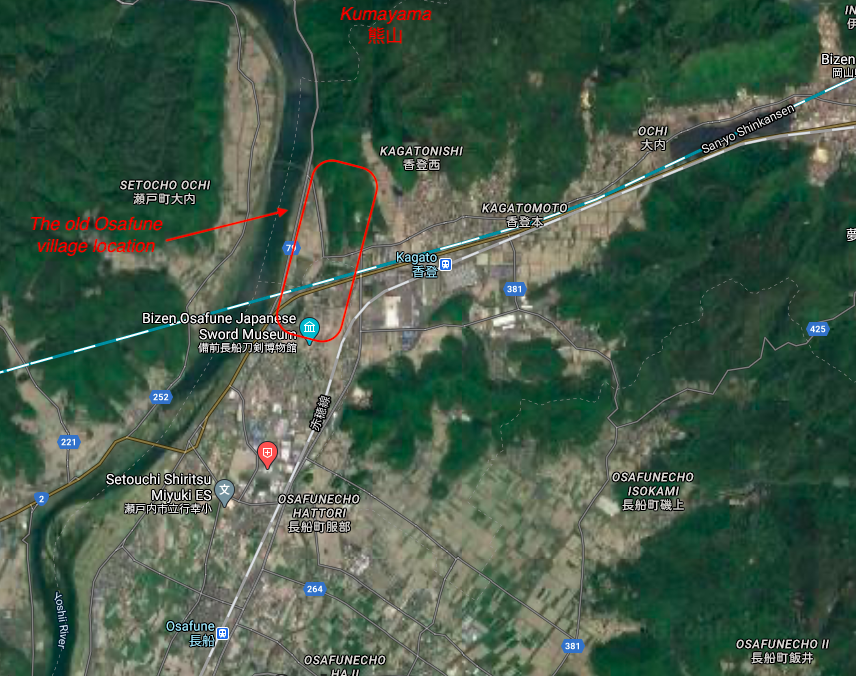
Figure 1. The old Osafune village location (source: Google map).
In the 10th month of the Bun ́ei 11 (文永, 1274), the invasion of 30,000 Mongolian troops had a major impact to the Kamakura Shogunate. After the first invasion, the shogunate made a great efforts to defend against a second, which they thought was sure to come soon. They better organised the samurai of Kyūshū and ordered the construction of forts, walls, and other defensive structures at many potential landing points to prevent the Mongol Army from landing. In addition, orders for a new swords production were placed in various famous smithing centres of Japan. Interestingly, some of the new swords were ordered to arm the troops for direct combat operations, and some were ordered to make offerings to temples throughout Japan to organise prayers for the successful reflection of the aggression. The swordsmiths of the Bizen province have always been famous for their exquisite products with beautiful hamon patterns. That is why many of the military leaders of that time ordered the manufacture of swords for themselves and as offerings to temples in Bizen Osafune. It was the increased demand for high quality swords and works made in a high artistic style that contributed to the rapid development of the Sōshū and Osafune schools. It is said that Nagamitsu was already the head of Osafune School at the time of Mongol invasions.
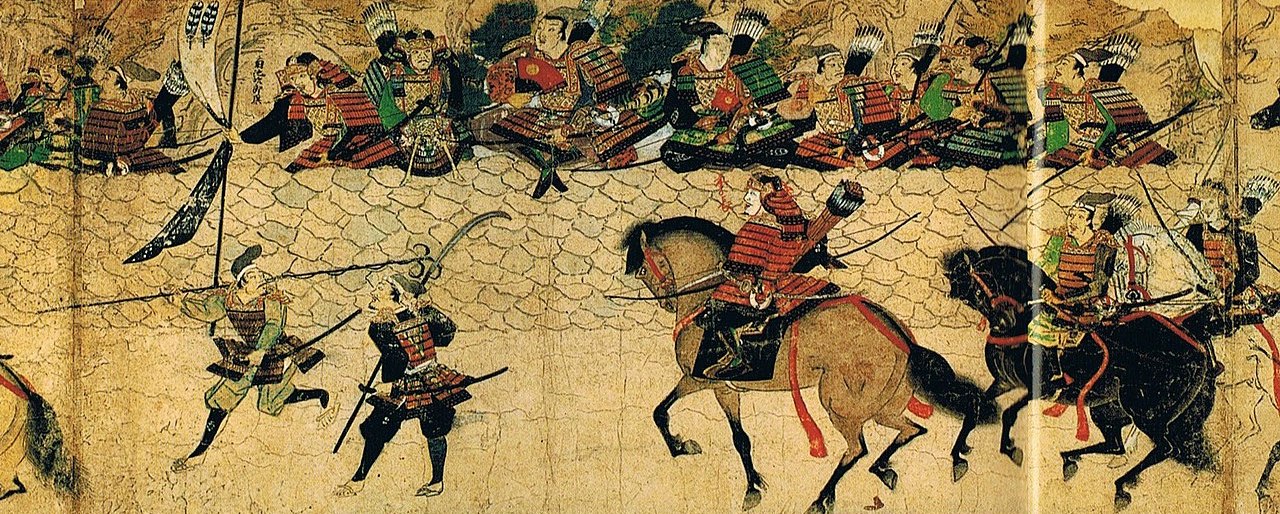
Figure 2. Japanese samurai defending the stone barrier at Hakata.
Bizen Osafune Nagamitsu (備前長船長光) was the eldest son and heir of Mitsutada (光忠) who was the founder of the Osafune School. According to the Kotō Meizukushi Taizen (古刀銘盡大全), Nagamitsu was born in the 1st year of the Jōō era (貞応, 1222) and died in the 5th year of the Einin era (永仁, 1297) in his 76 year. This is just the initial information from which to start studying the work of one of the greatest masters of the Japanese smithing art. Despite many examples of Nagamitsu’s works extant to our day, including dated and signed ones, there are many mysteries and ambiguities associated with his work and life. And all this despite the fact that many books and articles have been devoted on this subject. The existing rather large array of information about the Nagamitsu artistic activity, nevertheless, does not allow an unambiguous answer even to the seemingly question of how many generations of the master were in fact. Current point of view tends to lean toward the one-generation theory and a change in working styles by Nagamitsu during his long life and activity period. After all, only his survived dated works span the period from 1274 to 1316, not to mention the undated signed works that seem to span an even longer period.
However, this opinion was not always dominant and in this regard, it is important to trace how the genealogical line of the blacksmiths of the Osafune School was described in different sources from old manuscripts to modern editions. The generally accepted theory is that the earliest manuscripts from the Kamakura and Nanbokuchō period described one generation of Nagamitsu, and then, during the Muromachi period, due to a lack of information and, in some cases, loss of succession, the description of the Nagamitsu lineage, consisting of two generations, began to dominate. At the present time, after studying all aspects of the master's work, as well as the smithing features of his work, the theory of one generation has again become the most preferred. This explanation seems too simplistic. For further research and another, more detailed resolution, it is necessary to present all these important manuscripts with any information about Nagamitsu exactly in the form in which they were written, and not in theirs later interpretations.
Nagamitsu in ancient manuscripts
The Kaji Meishū (鍛冶銘集)
(this book, written during the Shōan era (正安, 1299-1302), has survived as a copy made in around Ōei era (応永, 1394-1428)
This book provides only brief information about swordsmiths and the main smithing schools. The fact that this manuscript contains the name Nagamitsu indicates that the master was quite famous at the time when this historical document was compiled. We can find here the genealogy of Osafune School, presented as follow:
Mitsutada (光忠, Nagamitsu’s parent) — Nagamitsu (長光, Mitsutada’s son) — Sanenaga (真長, Nagamitsu’s eldest son) —Iemitsu (家光, Nagamitsu’s elder son) — Toshimitsu (俊光, Nagamitsu’s son) —Kagemitsu (景光, Nagamitsu’s son)
The Kanchi-in Bon Mei Zukushi (観智院本銘尽)
(copied by Gyōzōbō Kōjun (行蔵坊幸順) in 1423, based on the records made from 1299 to 1316)
In this manuscript, we also find quite rare references to Osafune genealogy:
Nagamitsu, Osafune ryū — Kagemitsu, Bizen Osafune ryū, Nagamitsu’s son, Saemon no Jō — Kanemitsu, Osafune ryū, Kagemitsu’s son
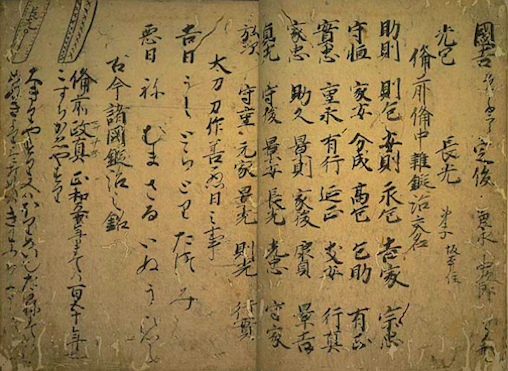
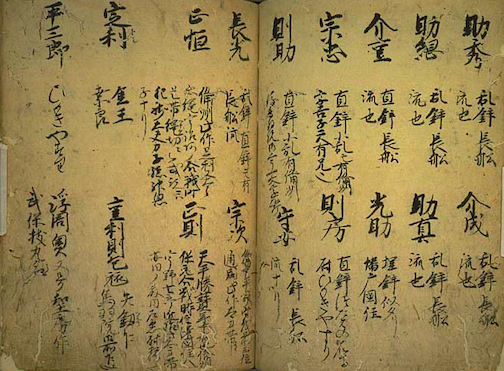
Figure 3: The Kanchi-in Bon Mei Zukushi pages.
The Kaji-meiji-kō (鍛冶銘字考)
(this manuscript was written in the 2nd day of the 10th month of the Kyōtoku 1 (享徳, 1452) by Tanimori (溪主).
We can find here the genealogy of Osafune School, presented in original as follow:

Figure 4. The Kaji-meiji-kō page.
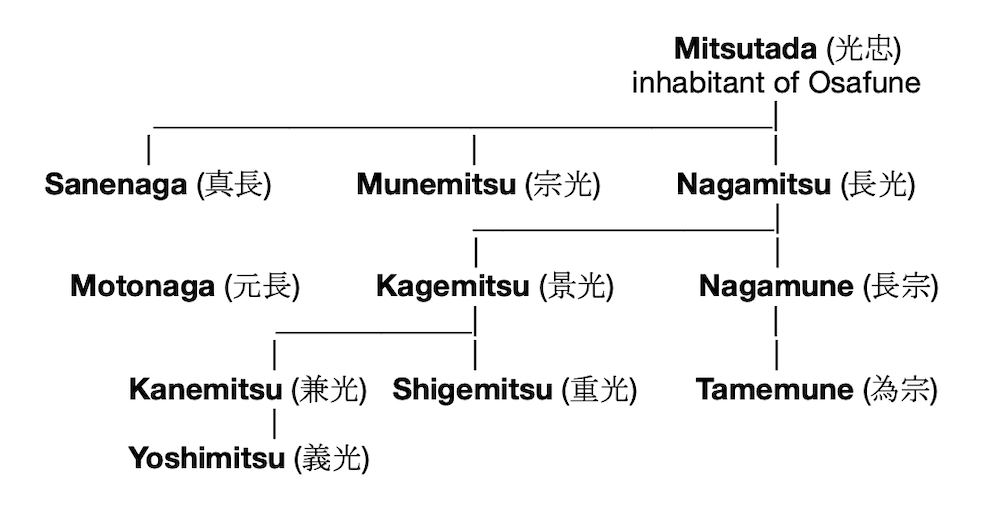
Summing up all of the information about Bizen Osafune School mentioned in the section Bizen kuni kaji-kō (備前国鍛冶等) of this book, we should present below the detailed genealogy as follow:
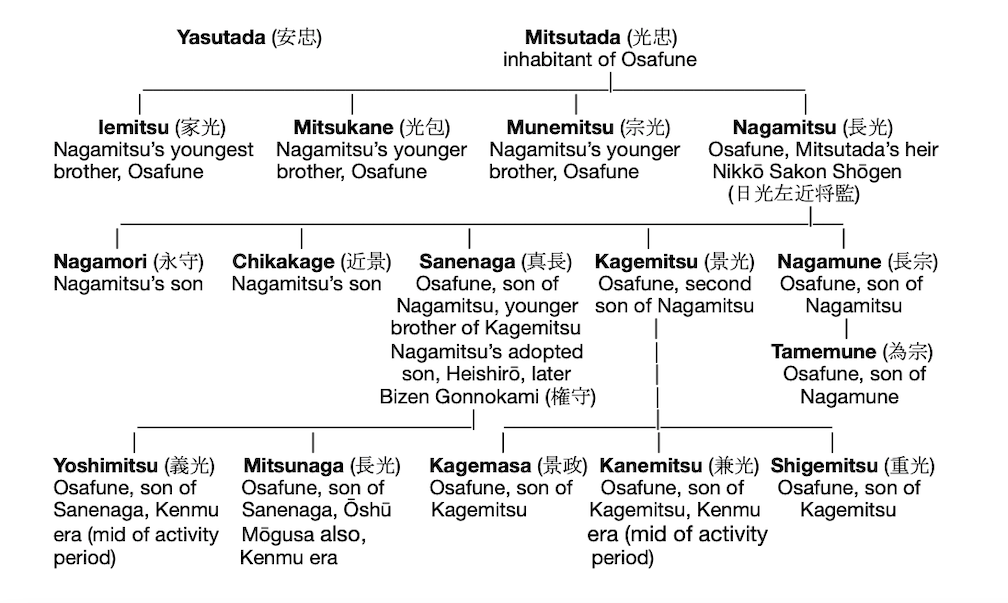
It is necessary to pay special attention to the fact that this is the earliest manuscript in which two very interesting facts are indicated: firstly, Nagamitsu's own name is designated as Nikkō Sakon Shōgen (日光左近将監) It is necessary to pay special attention to the fact that this is the earliest manuscript in which two very interesting facts are indicated: firstly, Nagamitsu's own name is designated as Nikkō Sakon Shōgen (日光左近将監) and secondly, according to this manuscript, Sanenaga was Nagamitsu's adopted son of and bore the names of Heishirō (平四郎) and Bizen Gonnokami (備前権守), which are uncharacteristic of the main line of Osafune. The name Nikkō, which is mentioned in the Kaji-meiji-kō, is very rare and practically not found in other swordsmiths. Perhaps it is somehow connected with Nikkō Futarasan jinja (日光二荒山神社, was founded in 767 by Shōdō shōnin), if we also remember that Nagamitsu also had the monastic name (hōmyō, 法名) Junkei (順慶). In addition, while paying tribute to the beauty of Futarasan jinja, the Japanese saying: «Never say "kekkō" (beautiful) until you've seen Nikkō». Although it is not known for sure whether this proverb existed at the time of Nagamitsu, it is possible that Nikkō name was associated with the generally recognized high artistic level of his work.
Another especially interesting detail concerns the information contained in the old manuscripts indicating that Nagamitsu belonged to the Fujiwara clan (藤原氏). Probably the entire line of swordsmiths of the Osafune School, starting with Mitsutada, belonged to this clan. Сonfirmation of this information can be found in the long signature used by Nagamitsu: 備前国長船住人左近将監藤原長光造 (Bizen kuni Osafune-jūnin Sakon Shōgen Fujiwara Nagamitsu tsukuru). However, there is no information about Kagemitsu's belonging to the Fujiwara clan, on the contrary, Kanemitsu is listed as one of this clan.
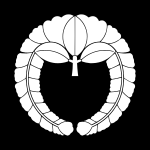
Mon of the Fujiwara clan
In some old manuscripts (the Kanchi-in Bon Mei Zukushi, for example), Sanenaga is referred to as Taira Sakon Shōgen (平左近将監), indicating that he belongs to the Taira clan (平氏). Combined with the information that Sanenaga was the adopted son of Nagamitsu, this fact indicates that the Osafune School accepted talented swordsmiths, who came from other, even opposing clans, into its ranks. Despite the fact that the Taira clan was destroyed by the Minamoto no Yoritomo in 1185, the clan's subsidiary lines continued to exist, later forming such famous families as: Go-Hōjō, Oda, Chiba, Miura, and Hatakeyama. The name Nikkō, which is mentioned in this manuscript, is very rare and practically not found in other swordsmiths.
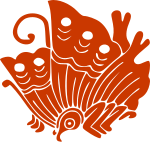
Mon of the Taira clan
The Chōkyō Meizukushi (長享銘尽).
(this manuscript was written in Chōkyō era (長享, 1487-1489).
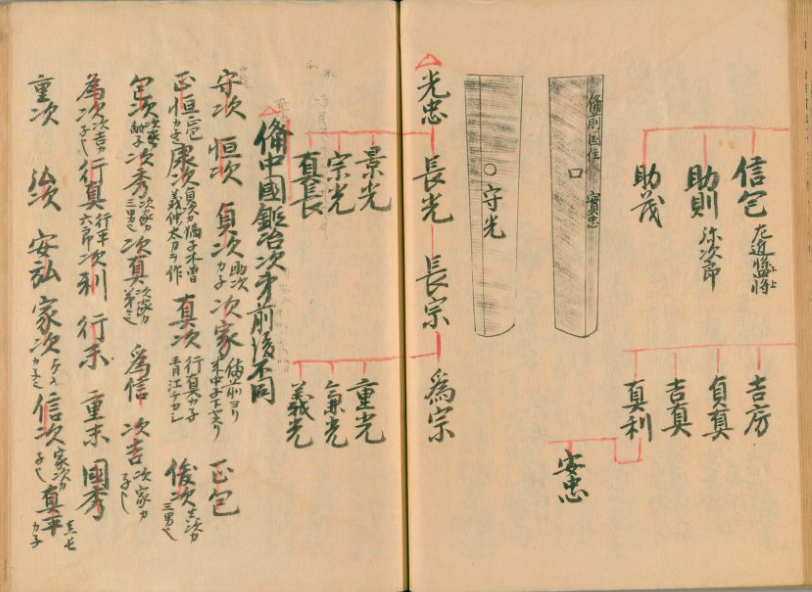
Figure 5. The Chōkyō Meizukushi page.

In addition to this genealogy, reproduced exactly in the form that is given in the original, this manuscript contains quite detailed textual information about the Osafune School. If this genealogy presented above is supplemented with information extracted from the text, then the final result can be presented in the following form:
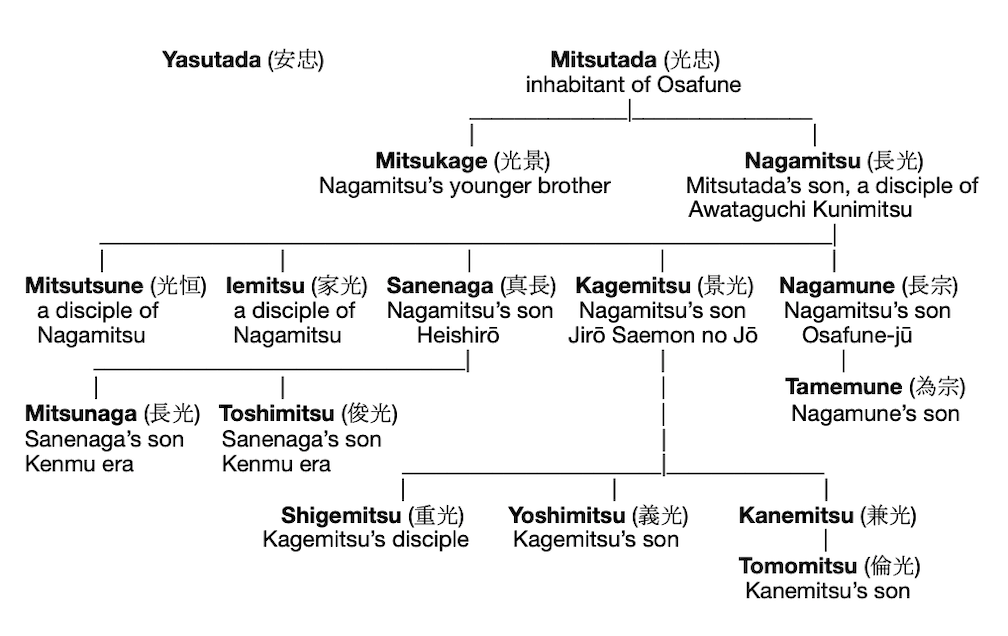
Particular attention should be paid to the fact that this manuscript indicates that Nagamitsu was a disciple of Awataguchi Kunimitsu (粟田口国光), one of the predecessors of the Sagami School and one of the best masters of the time. Thus, it can be assumed that Nagamitsu studied and worked in Kamakura for some time during the Ninji era (仁治, 1240-1243), given the fact that Kunimitsu died in 1244. This information is an indirect confirmation that a swordsmith named Nagamitsu was born in 1222 (no matter the first or only generation) and played an important role in the formation of the Osafune School. Quite often, Nagamitsu's skill level is compared to that of his father, Mitsutada. It is generally accepted that Nagamitsu did not drop off in any skill from his father when he inherited the forge and his skill in forging jigane is higher than Mitsutada. This agrees very well with the information that one of the teachers of Nagamitsu was Awataguchi Kunimitsu, a prominent representative of the Awataguchi School, whose swordsmiths were rightfully considered the best masters of jigane forging.
The Genki-gannen Tōken Mekiki Sho (元亀元年刀剣目利書)
his two volume manuscript was written in the 1st year of the Genki era (元亀, 1570).
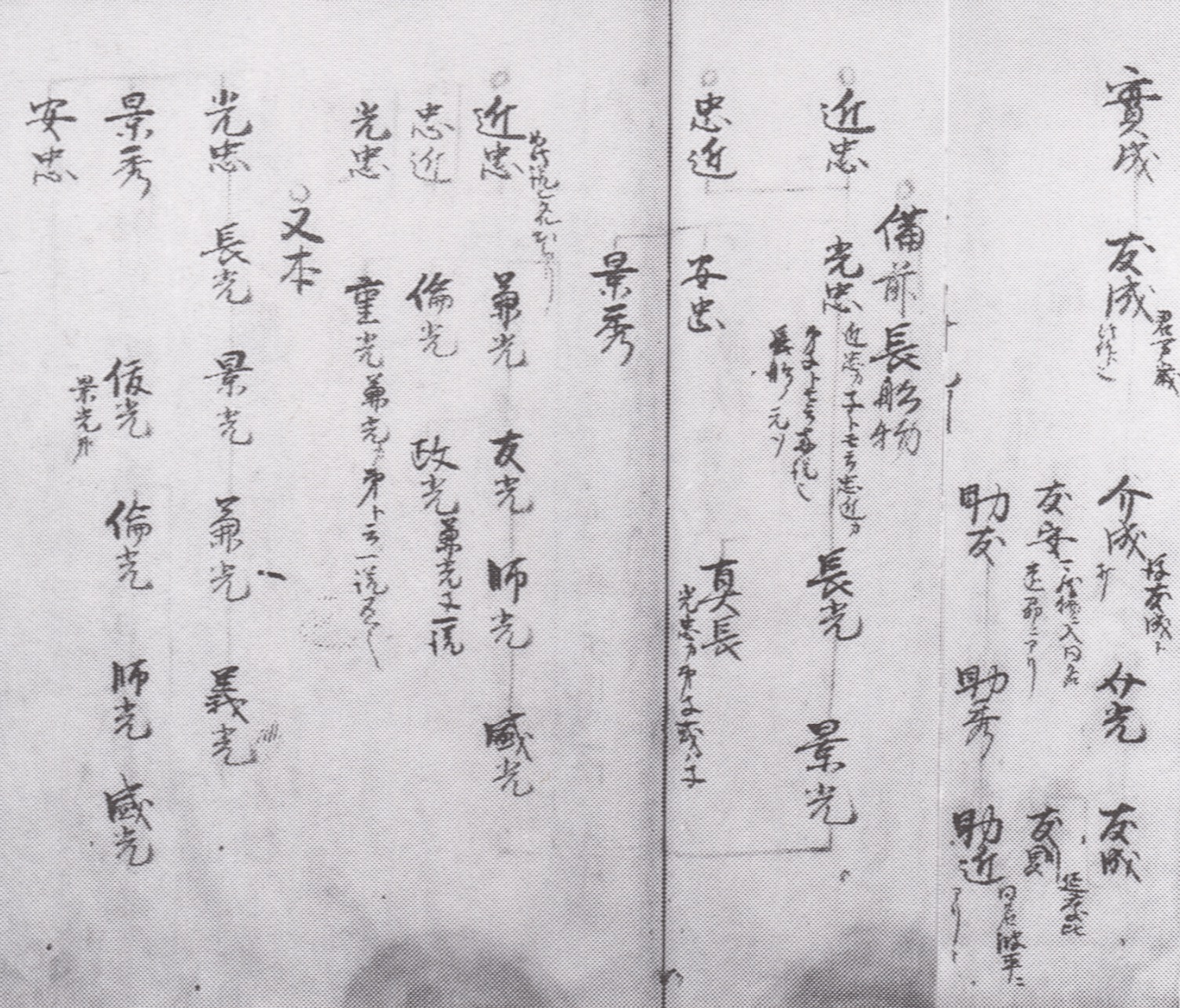
Figure 6: The Genki-gannen Tōken Mekiki Sho pages.
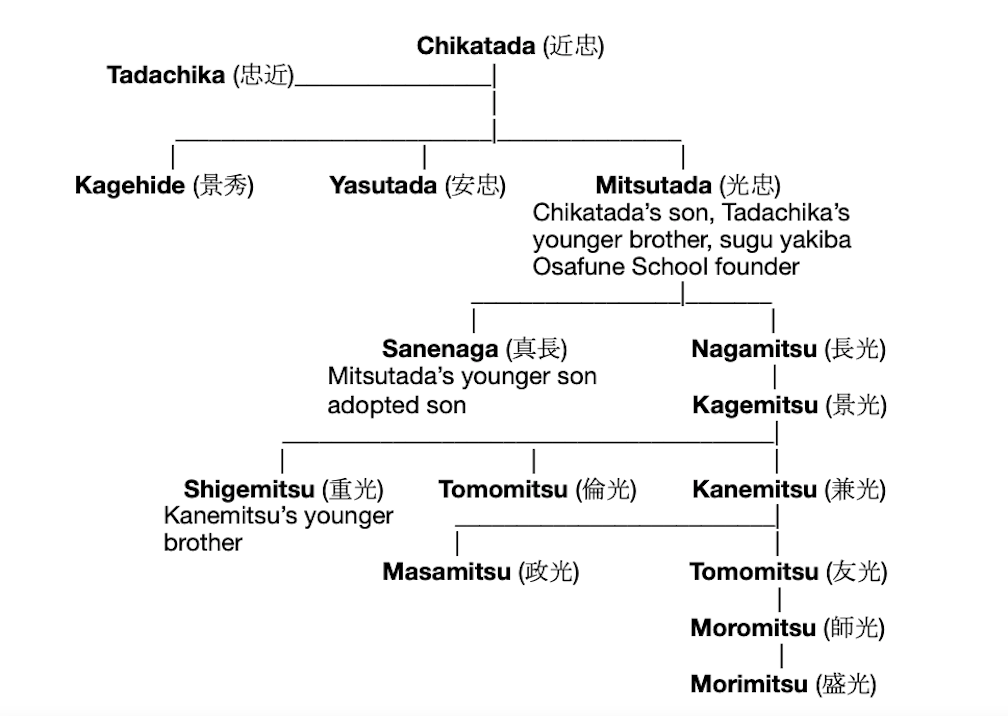
The Shinkan Hiden Shō (新刊秘伝抄)
This two volume book is rewritten version of old manuscript the Hidan Shō (秘談抄) was written by Utsunomiya Mikawa Nyūdō (宇都宮三河入道) who was one of the most important sword scholars of the Nanbokuchō period. The book was published by his descendant Takeya Sozaemon no Jō Riyan (竹屋惣左衛門尉理安) around the Tenshō era (天正, 1573-1592).

Figure 7: The Shinkan Hiden Shō page.
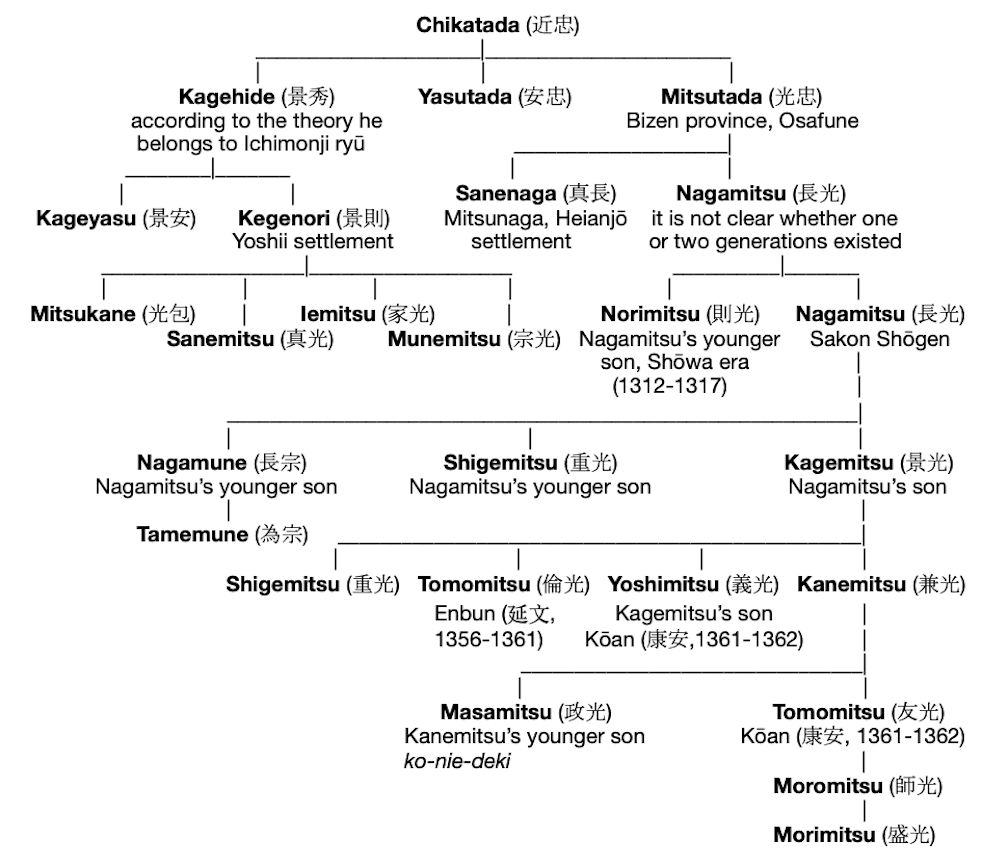
The Tsurugi Mekiki Densho (剣目利傳書), late Muromachi years.
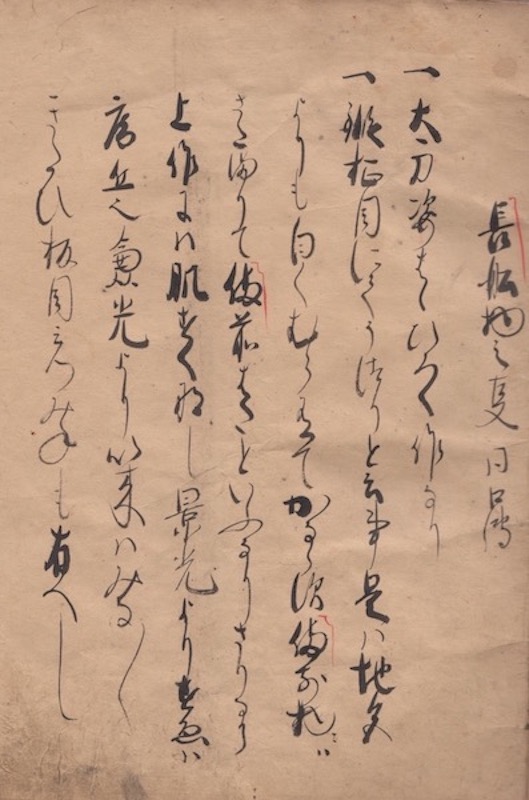
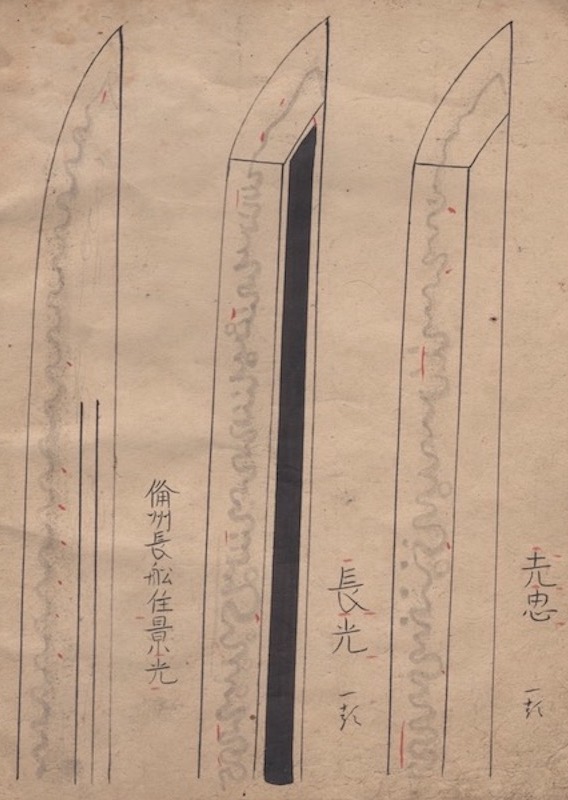
Figure 8: The Tsurugi Mekiki Densho pages.
The Kokon Meizukushi Taizen (古今銘盡大全),
the 1st edition of this manuscript was written in 1661 by Takeya family.
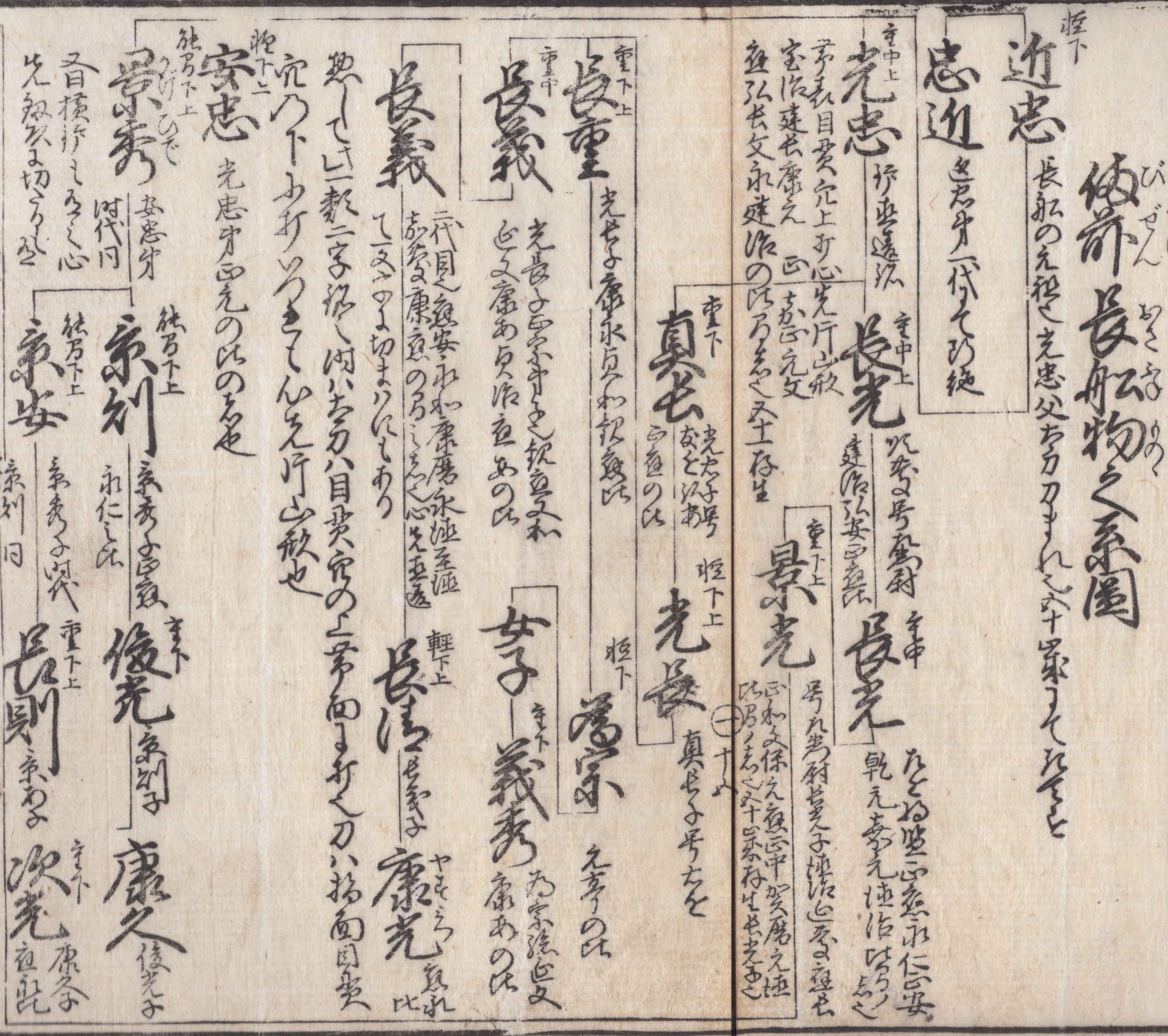
Figure 9: The Kokon Meizukushi Taizen pages (Volume 1, pp.15/1-15/2).
In the text part of this manuscript one can find the followed information about Nagamitsu’s works: Nagamitsu, there are swords made around Einin era (永仁, 1293-1299) which are similar to his father’s (Mitsutada) works; tachi are most common; mune type is iori-chū; swords made in chōji style are forged very high quality; clove petals rounded and very beautiful; swords made in hiro-suguha style have midare elements; bōshi made in midare style too; there is utsuri also; there are sone inferior level swords signed with the name Junkei; the second generation of Nagamitsu bore the name Sakon Shōgen; slender tachi sugata with iori-mune; ko-midare swords of fine suguha swords are most common; chōji swords are rare; katana has sugata with thin kasane and small fukura, in midareba or suguha style.
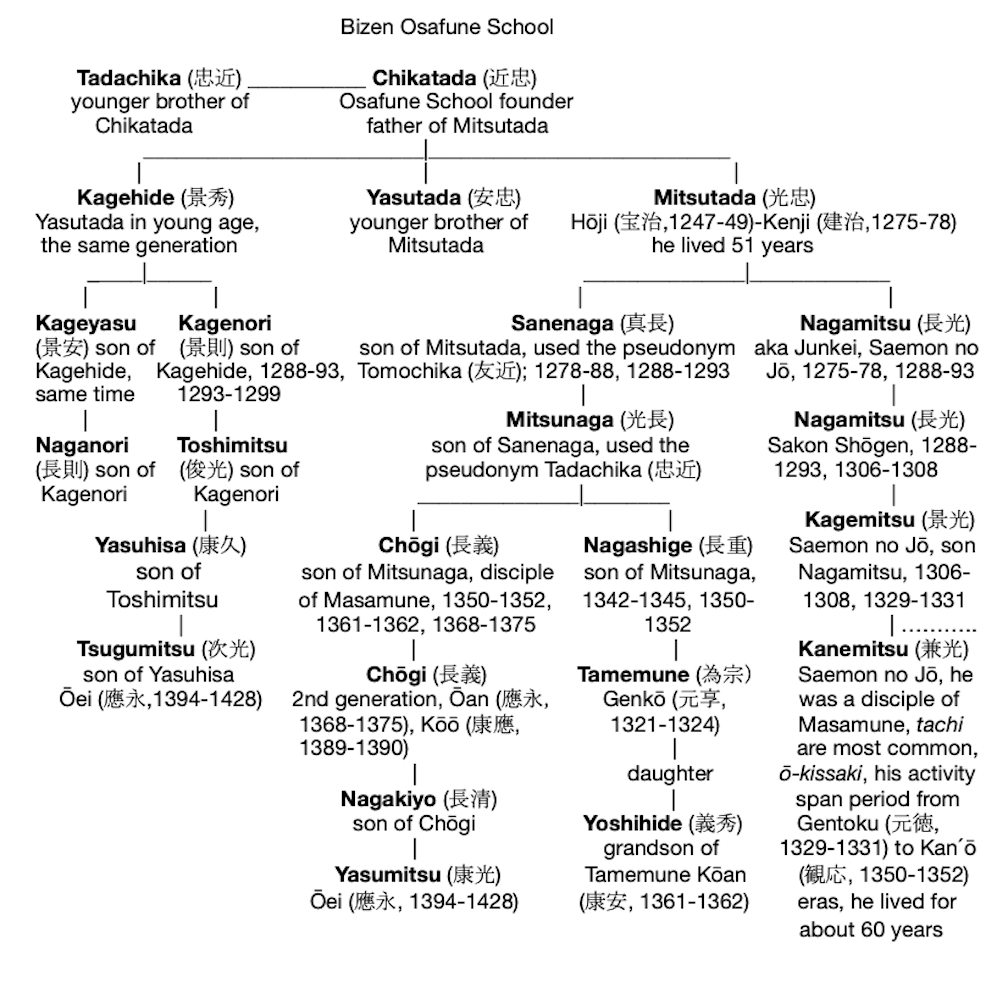
The Kotō Meizukushi Taizen (古刀銘尽大全).
Written by Ōgi Iori Sugawara Hirokuni (仰木伊織菅原弘邦), 9 volumes edition 1792.
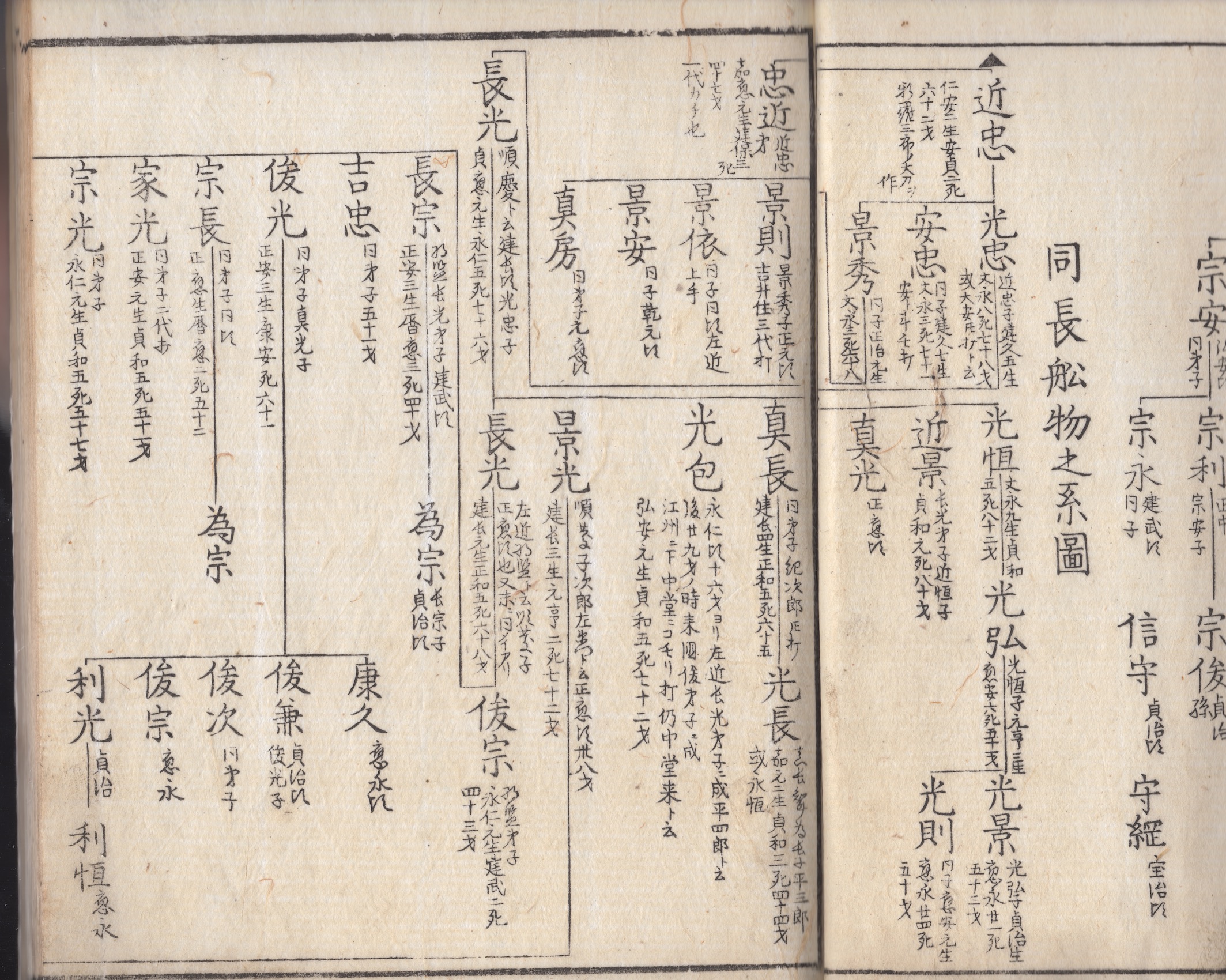
Figure 10: The Kotō Meizukushi Taizen pages (Volume 3, pp. 12/2-13/1).
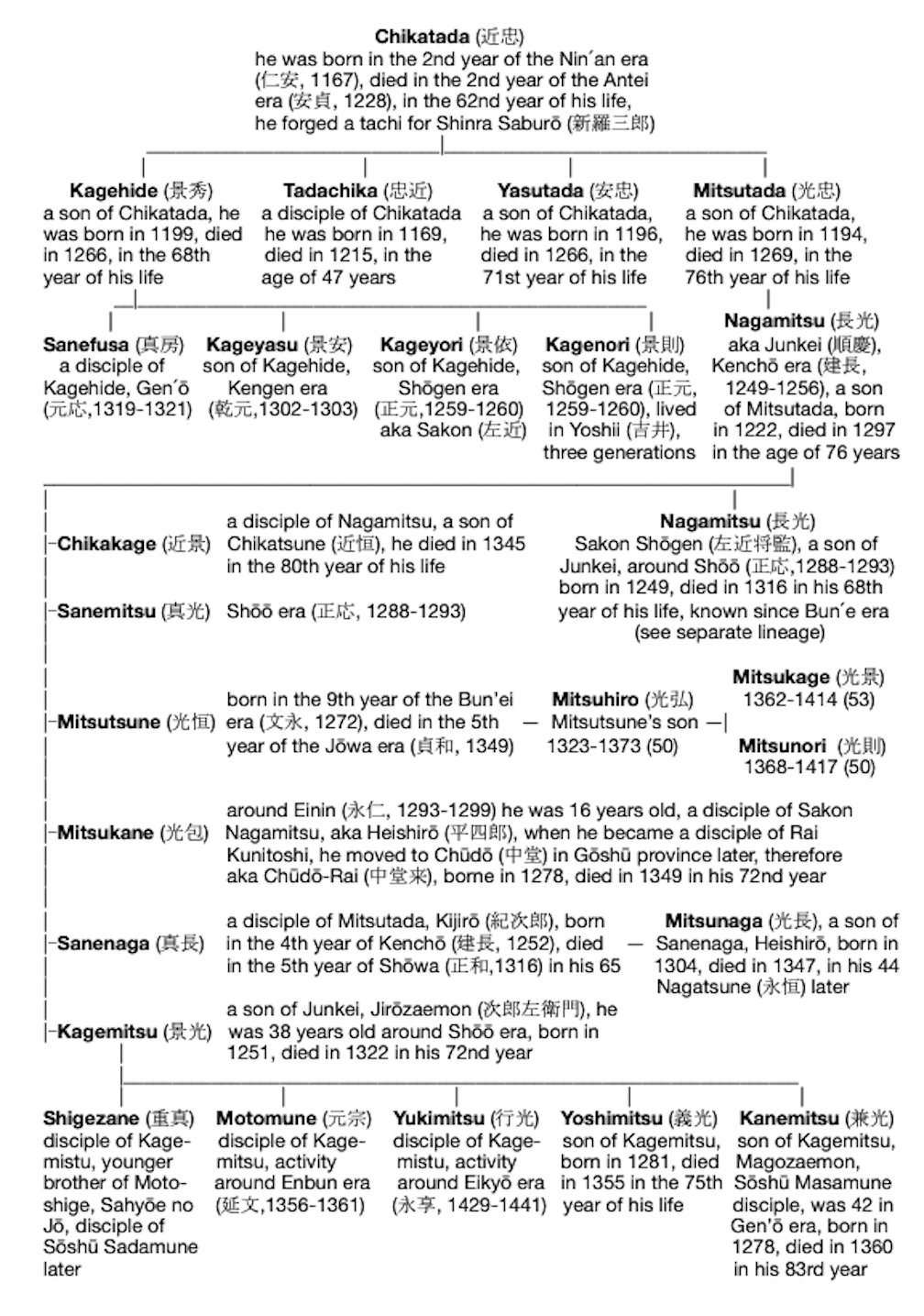
The Honchō Kaji Kō (本朝鍛冶考).
Written by Kamata Natae (鎌田魚妙), 12 volumes edition, Ōsaka, 1795.
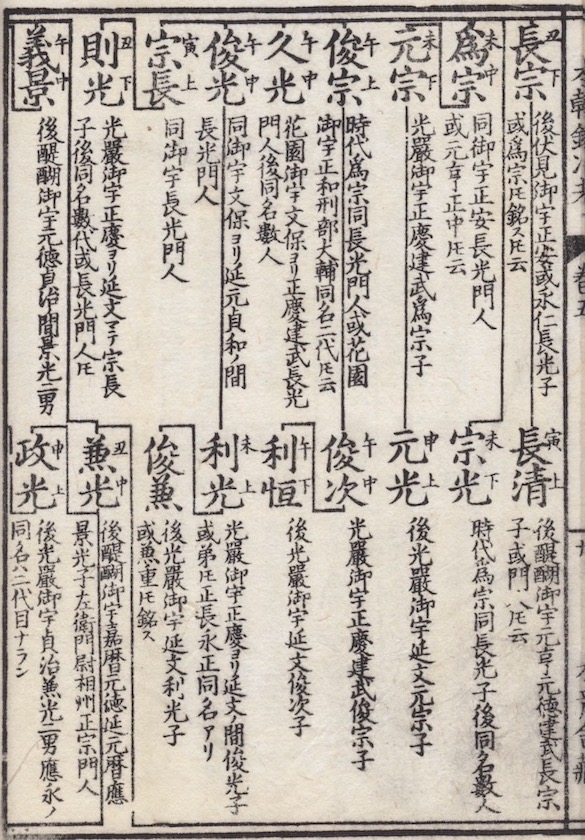
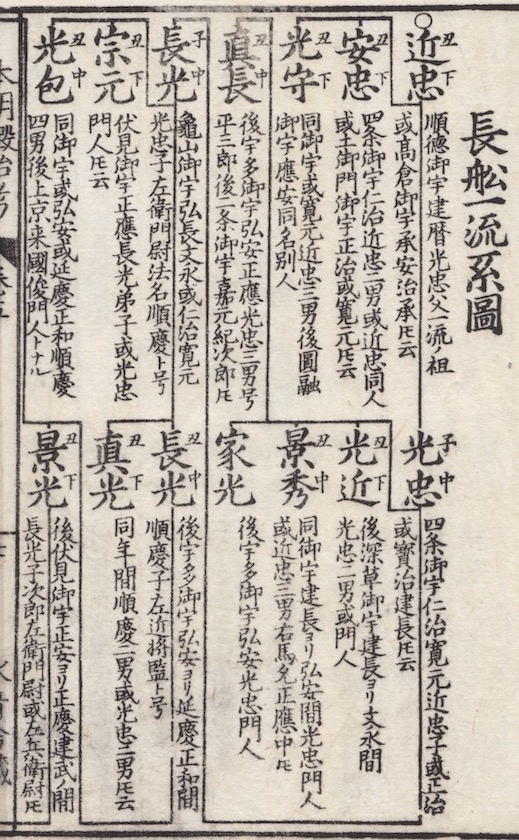
Figure 11. The Honchō Kaji Kō page (Volume "Rabbit", pp. 20/1-20/2).
It tells us that Chikatada’s creative activity period is related to the time of rein of Emperor Juntoku (順徳, 1197-1242), which spanned the years from 1210 through 1221, and the Kenryaku era (建暦, 1211-1213). Chikatada was the father of Osafune School founder: Mitsutada. He was born during the time of rein of Emperor Takakura (高倉, 1161-1181) and his activity began around the years of the Jō ́an (承安, 1171-1175) and Jishō (治承, 1177-1181) eras.
The peak of Mitsutada’s creative activity period belongs to the time of rein of Emperor Shijō (四条, 1231-1242), which spanned the years from 1232 through 1242, and the Ninji era (仁治, 1240-1243). Mitsutada was the son of Chikatada and was born around the Shōji era (正治, 1199-1201), his activity spanned the years of the Hōji (寶治, 1247-1249) and Kenchō (建長, 1249-1256) eras.
The peak of Nagamitsu’s creative activity period belongs to the time of rein of Emperor Kameyama (亀山, 1249-1305), which spanned the years from 1260 through 1274, and the Kōchō (弘長, 1261-1264) and Bun ́ei (文永, 1264-1275) eras. His activity began around the years of Ninji (仁治, 1240-1243) and Kangen (寛元, 1243-1247) eras. He was the son of Mitsutada. Nagamitsu bore the honorary title Saemon no Jō (左衛門尉) and monastic name Junkei (順慶).
The nidai Nagamitsu’s creative activity period belongs to the time of rein of Emperor Go-Uda (後宇多,1267-1324), which spanned the years from 1274 through 1287 and the eras interval: Kōan (弘安, 1278-1288), Enkyō (延慶, 1308-1311), Shōwa (正和, 1312-1317). He was the son of Junkei and bore the name Sakon Shōgen (左近将監).
Thus, summing up, we can supposed that the main line of Osafune was under the direct patronage of the Fujiwara clan and the heirs had official titles in which a clear hierarchy can be traced. For example, the Nagamitsu’s title Sakon Shōgen is "senior" in relation to the title of Saemon no Jō of his son Kagemitsu. At this time, there were not many smiths who used the official title when signing their works, for example: Awataguchi Kunimitsu, Sōshū Sadamune, Higo Kunitomo, Yamato Sadayoshi, Ko-Aoe Sadatsugu, Ko-Aoe Tsunetsugu, Aoe Hidetsugu, Bizen Kageyori, Bizen Naganori, Yoshioka-Ichimonji Sukemitsu, and Yoshioka-Ichimonji Sukeyoshi. However, this almost continuous «concentration» of official titles in the lineage is not found in any other school.
According to so-called one generation theory, Nagamitsu was Mitsutada’s son and bore the first name Saemon no Jō (左衛門尉). He entered the priesthood in old age and took the monastic name (hōmyō, 法名) Junkei. It is known that in the 5th year of the Shōwa era (正和, 1316) he was 68 years old and soon died. From the ancient times, Junkei and Nagamitsu has been regarded as the same person, but in recent years it has become a popular theory that they are a different persons in view of the difference in the style of they works (Junkei’s works are inferior comparing to Nagamitsu’s) and in hamon pattern especially.
According to so-called two generation theory, shōdai Nagamitsu was Mitsutada’s son and his monk name was Junkei. He was born in the 1st year of the Jōō era (貞応, 1222) and died in the 5th year of the Einin era (永仁, 1297) in the 76th year of his life. The peak of his smithing activity falls on the years of the Kenchō era (建長, 1249-1256). Nidai Nagamitsu was shōdai Nagamitsu’s son and is commonly referred as Sakon Shōgen (平左近将監). He was known from Bun ́ei era (文永, 1264-1275) and the peak of his smithing activity falls on the years of the Shōō era (正応, 1288-1293). He was born in the 1st year of the Kenchō era (建長, 1249) and died in the 5th year of the Shōwa era (正和, 1316) in the 68th year of his life.
Finally, the main thing to note is that in the old manuscripts Nagamitsu is described as one single swordsmith, that is, it seems this was one generation of the master, who had a relatively long period of creative activity. This fact is used by proponents of the theory of one-generation theory to argue their own point of view. However, this argument cannot be accepted after careful examination of the structure of the construction of old handwritten texts. All of them contain an exceptionally brief description of the smithing schools known at that time and the most famous and prominent representatives of these schools. Detailed data and detailed genealogical lines are not provided in them. In addition, there is a whole time period when the theory of one generation and the theory of two generations coexisted together, that is, there was no clear dividing line when one theory ceased to exist and another began to exist. All this indicates to us not at all a loss of communication and not a lack of information, but simply a gradual change in the principles of presenting the material and the transition from a short to a more minute and detailed description, including a specification of the characteristic features of the blacksmith's style of the master. This is probably due to the fact that the source of information used by the authors to write their research has changed. If during the Kamakura-Nanbokuchō period, it seems that the same source is constantly being rewritten with some additions, then later studies are based on data collected over centuries of work by appraisers and polishers, that is, their own clan records and chronicles.
It seems that for sword experts prior to the beginning of the Muromachi period, the problem of attribution to the first or second generation of Nagamitsu did not exist at all. Experts of that time, when making the kantei, described the nakago and sugata of the sword, and not the peculiarities of forging and the revealed activity and design of the hamon. This was directly related to the development of the art of polishing. The fact is that before the beginning of the Muromachi period, the polishing techniques of that time allowed only the activity of the hamon to be successfully visible, leaving the ji elements ignored; jizuya (地艶, literary can be translated as ji gloss) and nugui (拭い, cosmetic polishing process) stages of finishing polish came in to the practice in the beginning of the Edo period only; migaki (磨き, burnishing) and hadori (刃取り, steps for express the contrast between ji and hamon) got their proper development only during the Meiji period. Ancient experts simply did not see the differences that are now available thanks to the development of polishing technology.
The ancient appraisals simply did not see the differences that are now available thanks to the development of polishing technology, and therefore, analyzing only nakago and encountering mainly the niji-mei signature, they classified all works in one category (Nagamitsu) without further detailing (shodai, nidai, Junkei). The first signs of describing elements of activity appear in the Nōami Hon Mei-zukushi (能阿弥本銘尽), and with the beginning of the Muromachi period, these descriptions began to acquire a systemic character. Therefore, it became obvious that it was necessary to re-analyze Nagamitsu's work, since the prevailing opinion was that one smith could not work in two completely different styles. It is possible that experts, based on old records, conducted a new analysis, as a result of which the modern idea of two generations of Nagamitsu emerged.
Nagamitsu signatures
Considering the legacy of Nagamitsu, one can note that he ranks in first place of all swordsmiths in the number of signed masterpieces that exist. Many of Nagamitsu’s swords have survived to the present day, both those with a signature and others bearing a signature and a date. The dates of these swords cover the period from the eleventh year of Bun ́ei (文永, 1274) to the second year of Kagen (嘉元, 1304). The signed works (there are about 150 of Nagamitsu's inscriptions, which are currently widely known) include the following variants of his signature:
長光 (Nagamitsu) 118 swords
備前国長光 (Bizen kuni Nagamitsu) 1 sword
長船長光 (Osafune Nagamitsu) 2 swords
長船住人長光 (Osafune-jūnin Nagamitsu) 1 sword
備州長船住長光 (Bishū Osafune-jū Nagamitsu) 2 swords
備前国長船長光 (Bizen kuni Osafune Nagamitsu) 1 sword
備前国長船住長光 (Bizen kuni Osafune-jū Nagamitsu) 7 swords
備前国長船長光作 (Bizen kuni Osafune Nagamitsu saku) 2 swords
備前国長船長光造 (Bizen kuni Osafune Nagamitsu tsukuru) 2 swords
備前国長船住長光造 (Bizen kuni Osafune-jū Nagamitsu tsukuru) 3 swords
備前国長船住人長光造 (Bizen kuni Osafune-jūnin Nagamitsu tsukuru) 1 sword
備前国長船住左近将監長光造 (Bizen kuni Osafune-jū Sakon Shōgen Nagamitsu tsukuru) 7 swords
備前国長船住人左近将監藤原長光造 (Bizen kuni Osafune-jūnin Sakon Shōgen Fujiwara Nagamitsu tsukuru) 1 sword
熊野三所権現 長光 (Kumano Sansho Gongen Nagamitsu) 1 sword
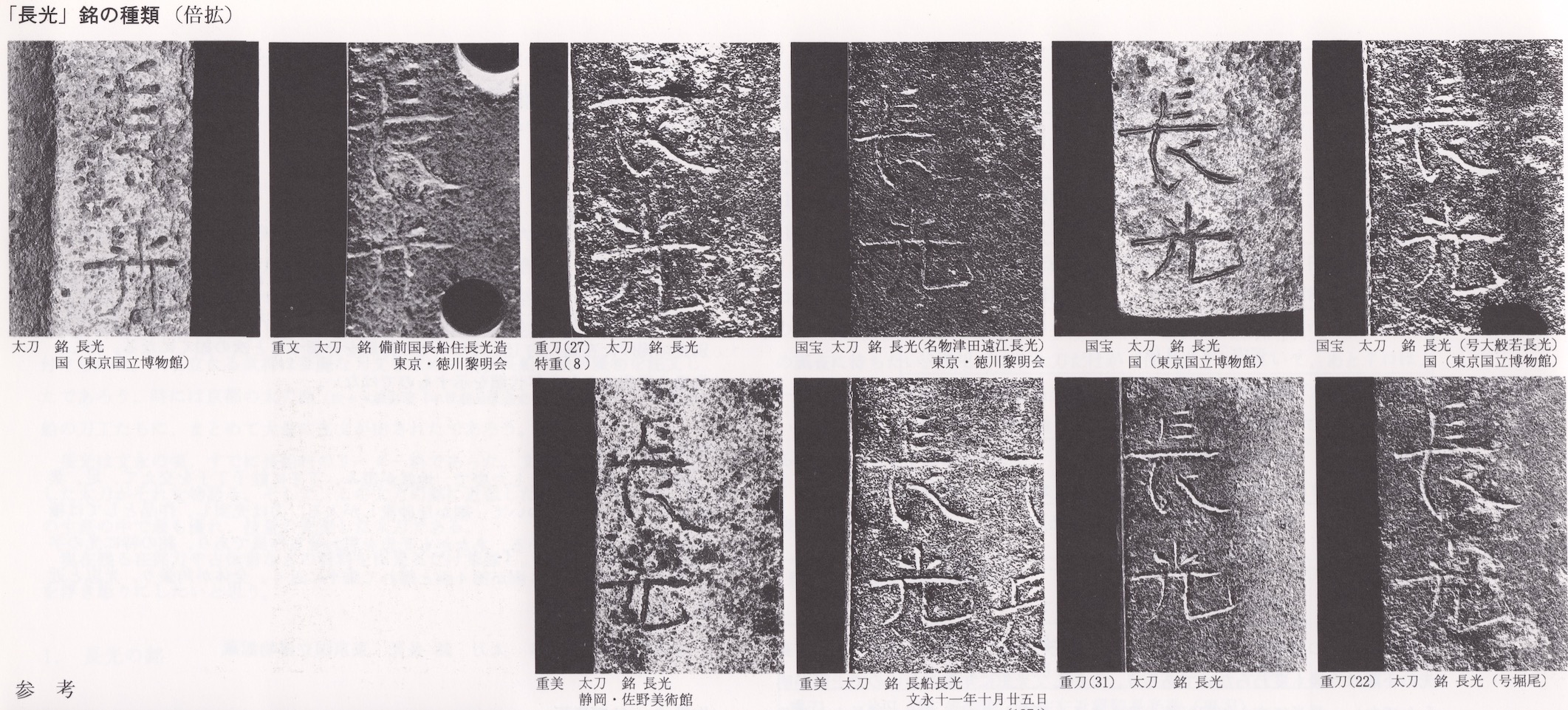
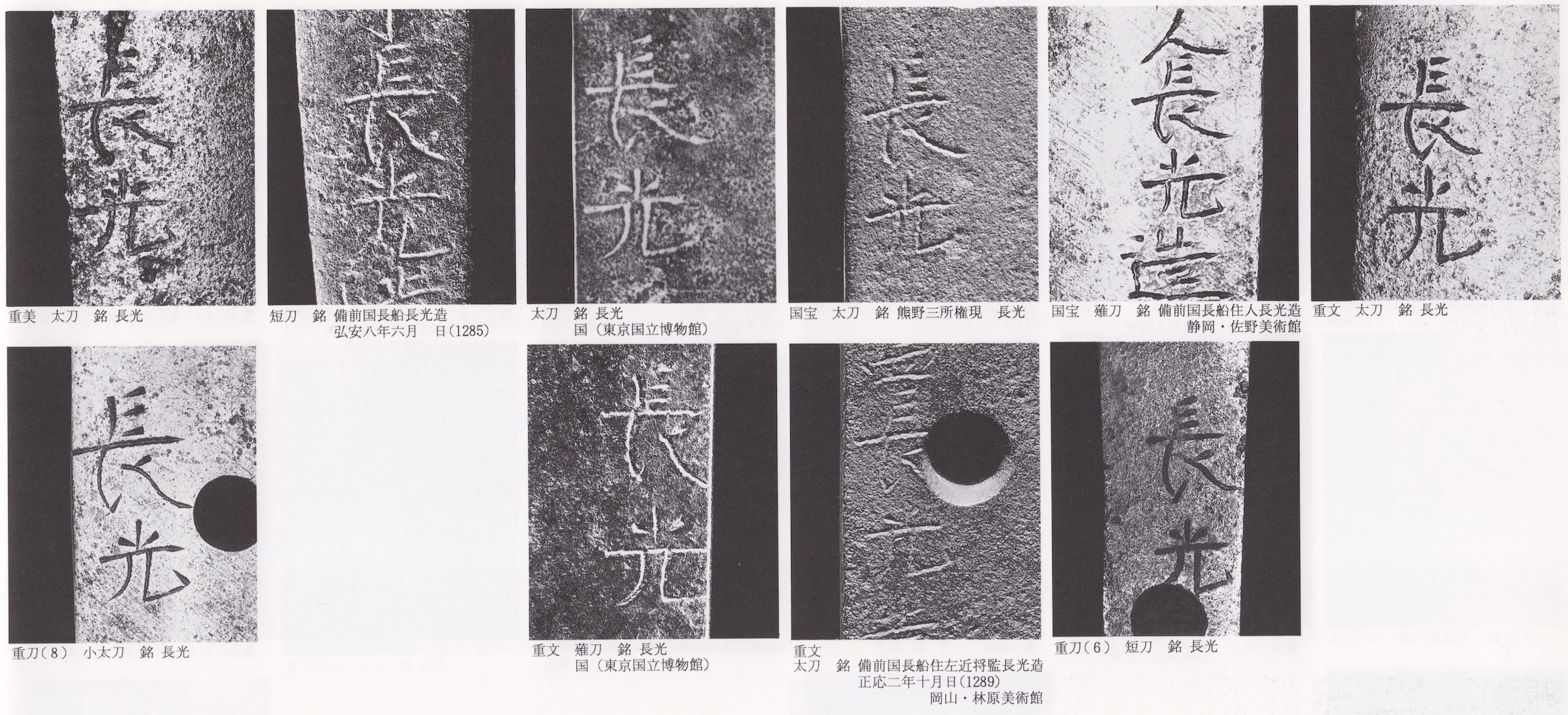
Figure 12: Different types of the Nagamitsu’s signatures (source: the Nagamitsu Ten (長光展) by the Sano Museum, 1989, pp.134, 135).
It can be noted that there are about 14 signature options that Nagamitsu used to sign his works. Such an unusually high variability can be noted only in Shintogō Kunimitsu’s works, who used about 9 variants of signatures. As with Shintogō, the niji-mei type of signature is much more common. Such a variety of signatures, as well as a rather long period of creative activity, which is confirmed by dated works and extant oshigata, allows us to assume that not all of these works were forged by Nagamitsu himself. This fact is one of the main arguments in favor of the theory of the existence of two generations of the master. In addition, attention is drawn to the variability of the most common signature with the niji-mei style, which may indicate both the existence of two generations of the master, and the fact that the master's disciples could have signed the name of Nagamitsu. This suggests that Nagamitsu was the head of a fairly large clan of swordsmiths and the clan's products were very popular and were in great demand among the military class. Thus, we can consider the version of history in which some works attributed to Nagamitsu, might also include products from second generation, signed with the and signed in niji-mei style. Nor can we exclude the possibility that some works with the so-called daimei (代銘) signature existed, when a disciple had to sign a ready-made work of his teacher and engraved his teacher’s name on it, trying to accurately copy its style.
Back in the days of Mitsutada, there was a massive migration of blacksmiths of the Ichimonji school, such as Sukefusa (助久), for example, in Osafune. The Kanchi-in Bon Mei Zukushi, opposing the swordsmiths of the Osafune School, lists more than 40 masters, many of whom are even unknown today. Therefore, it can be said that at the end of the Kamakura period, Osafune was a center of smithing skills and its core was the line of Mitsutada-Nagamitsu masters.
Nagamitsu smithing art styles
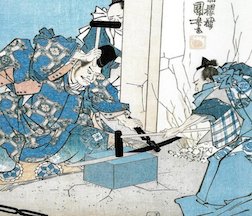
The blacksmithing work of Nagamitsu is highly variable and it is believed that there are three main styles in the works of the master.
1.Early years (shoki). Grand and wide sugata of the middle Kamakura period with a tendency to ikubi-kissaki; swords usually have bohi and works at the end introduce more horimono elements; hada tends to sumi-hada (澄肌) with darkish areas; chōji mixed with kawazu-no-ko chōji hamon with the addition of ashi, yō and ko-nie; beautiful sunagashi; in general, these are very beautiful and impressive works in style very close to Mitsutada's style. The signature is made in the niji-mei style with the chiselling of the «mitsu» (光) kanji very similar to Mitsutada.
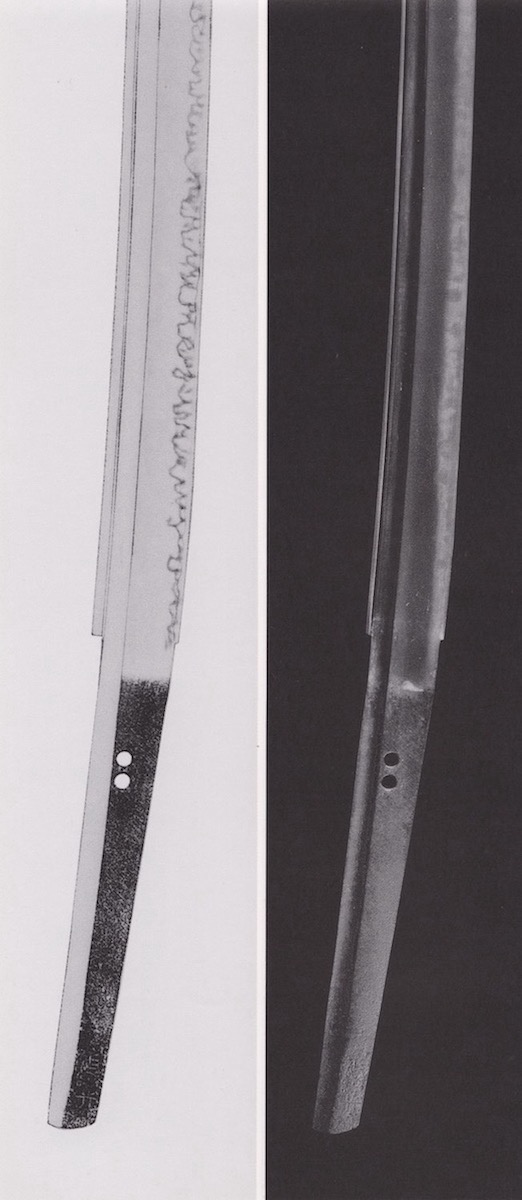
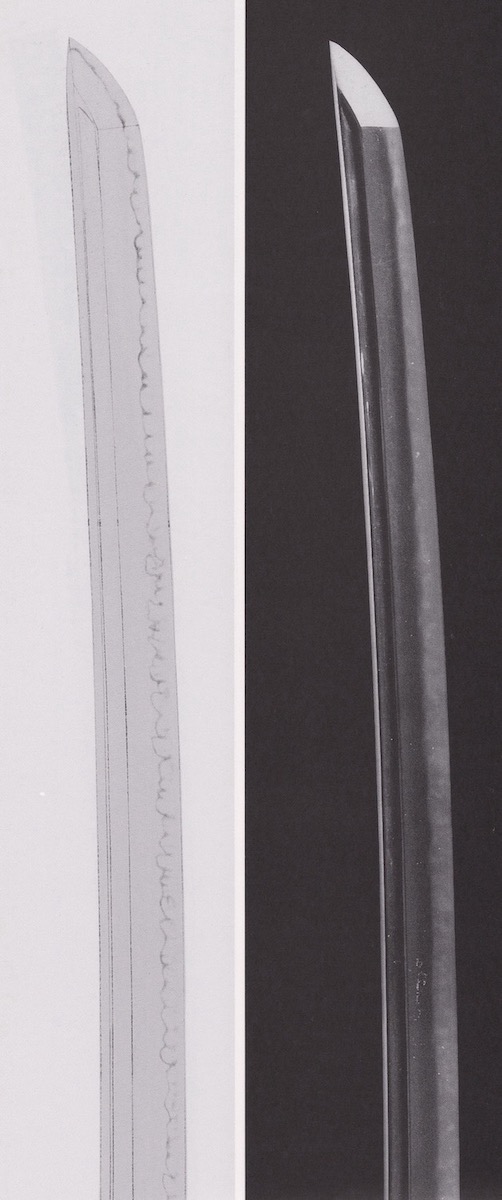
Measurements: nagasa - 70.6 cm; sori - 1.5 cm; motohaba - 2.9 cm; sakihaba - 2.3 cm; kissaki nagasa - 3.6 cm; nakago nagasa - 18.6 cm.
Figure 13: Tachi signed Nagamitsu, Tōkyō National Museum.
2.Golden years type 1. Gorgeous mid-Kamakura sugata with ikubi-kissaki; yakiba is high; ō-chōji mixed with kawazu-no-ko chōjiI; rounded-head chōji cloves are gentle but not narrow; bōshi is midare; this style is little inferior comparing to described above.
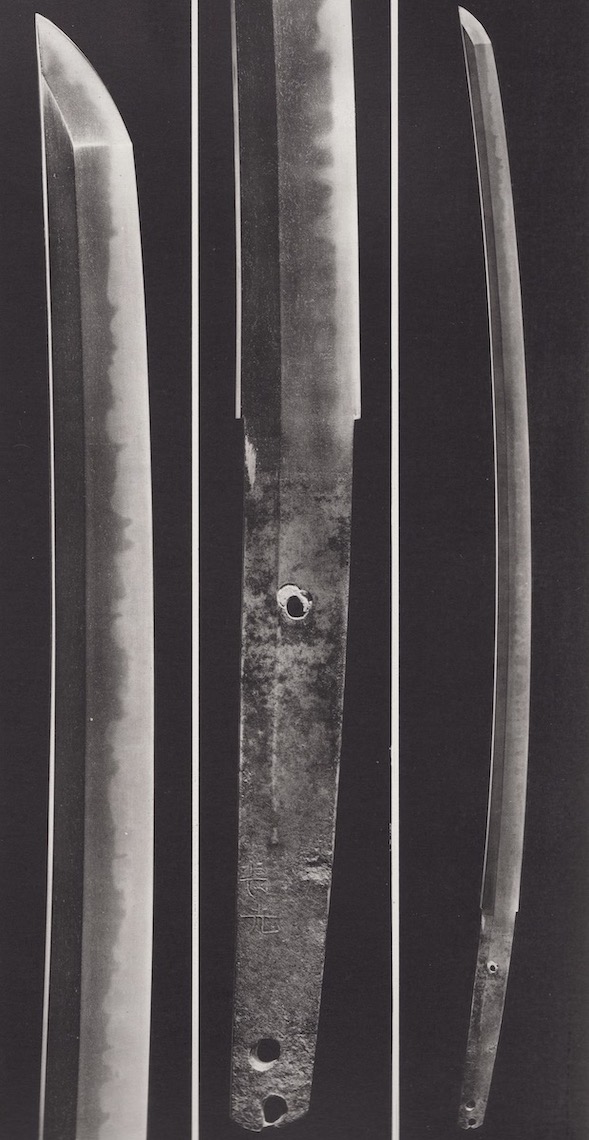
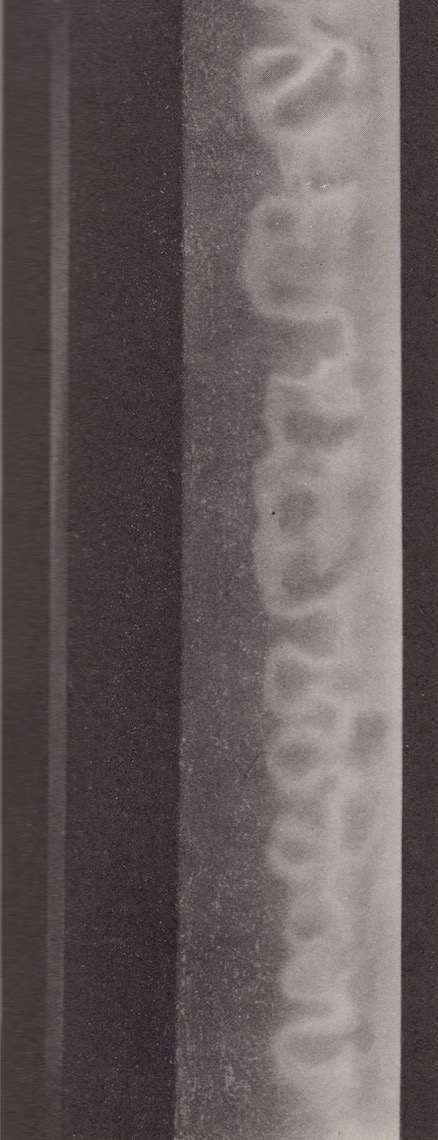
Measurements: nagasa - 71.96 cm; sori - 2.3 cm; motohaba - 3.03 cm; sakihaba - 2.3 cm; kissaki nagasa - 3.33 cm; nakago nagasa - 17.27 cm.
Figure 14: Kokuhō Tsuda-Totomi Nagamitsu. Collection of Tokugawa Art Museum.
3.Golden years type 2. In addition hamon in nie-deki; kawazu-no-ko chōji; yakiba is high, shinogi is low; yakiba is low in the areas yakidashi and monouchi especially; standing-out jihada; bōshi is midare; this group includes some of the most unique and rare works of Nagamitsu. Approximately 10% of swords are of the styles listed in items 1-3.
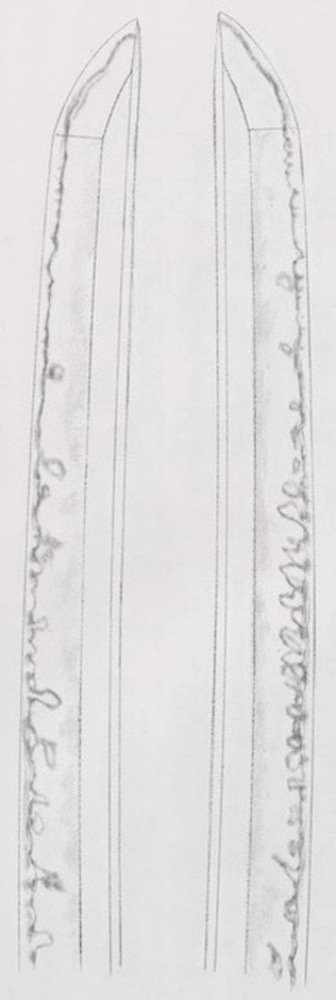



Measurements: nagasa - 70.2 cm; sori - 2.1 cm; motohaba - 2.9 cm; sakihaba - 2.1 cm; kissaki nagasa - 3.2 cm; nakago nagasa - 17.4 cm.
Figure 15: Tachi mei Nagamitsu, Jūyō Tōken #31.
4.Rounded-head chōji cloves. The chōji cloves are rounded and arranged in the same size (with controlled height) from the machi to the saki; bōshi is slight midare; this style is the most difficult to execute and there are very few surviving swords made in this style. (around 10% of all extant Nagamitsu’s swords)




Measurements: nagasa - 68.6 cm; sori - 2.6 cm; motohaba - 2.85 cm; sakihaba - 1.95 cm; kissaki nagasa - 3.3 cm; nakago nagasa - 19.8 cm.
Figure 16: Tachi mei Nagamitsu, Jūyō Tōken #22.
5.Mixture of different types of hamon. The mixture of hamon pattern is the most characteristic type for Nagamitsu, which consists of a mixture of different varieties: kawazu-no-ko chōji, atama no maru chōji, gunome, yamagata-gunome. These types of hamon, mixed in various ways, make the pattern of the Nagamitsu swords especially attractive.
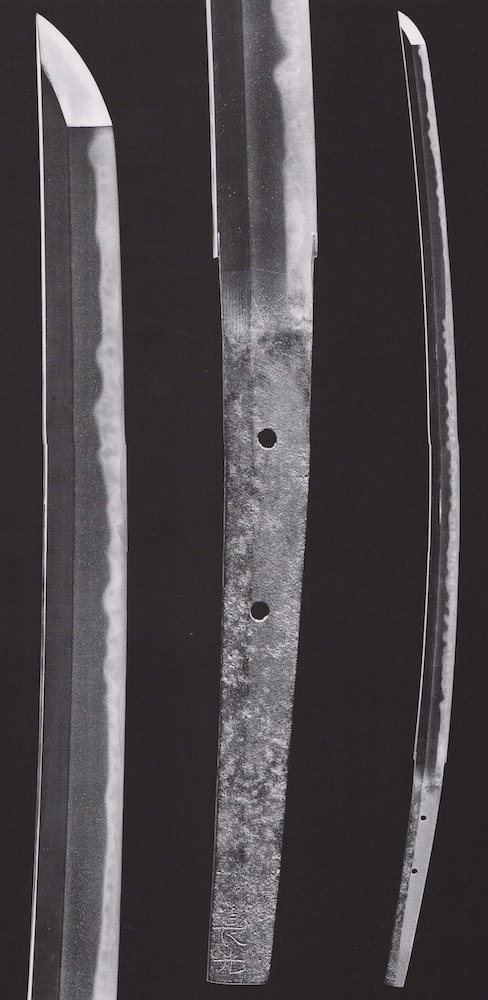
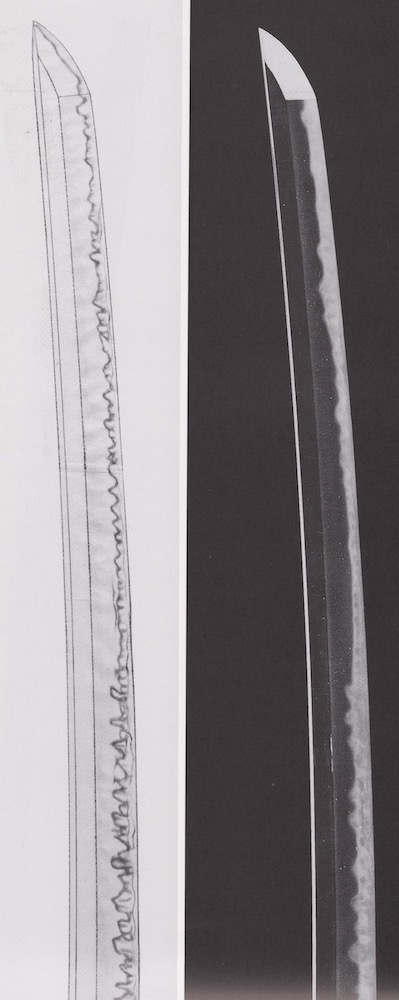

Measurements: nagasa - 68.8 cm; sori - 2.0 cm; motohaba - 2.9 cm; sakihaba - 2.1 cm; kissaki nagasa - 3.35 cm; nakago nagasa - 21.9 cm.
Figure 17: Kokuhō mei Nagamitsu. Tōkyō National Museum.
6.Kataochi-gunome for tanto swords made in early years. This type of hamon which is similar to a wind over sea waves in the form of gunome waves was used by the master when making tanto. It can be also be seen in tanto dated the 8th year of the Kōan era (弘安, 1285).


Measurements: nagasa - 23.1 cm; motohaba - 2.1 cm.
Figure 18: Tanto signed: Bizen (no) Kuni Osafune Nagamitsu tsukuru; dated: on the 6th month, 1285.
7.Gunome-chōji style. Ko-chōji, gunome waves mixed in excellent proportion and balance; bōshi tends to midare, made in the typical san-saku bōshi form; there is midare-utsuri. Without exaggeration, it can be said that this is the most common style used by Nagamitsu. This style is very difficult to confuse with others, and about half of all the master's works were made using it. It is because of these qualities that this style was more copied and repeated, both by the students of Nagamitsu and by other masters of the Osafune School, becoming a kind of standard. it was in this style that Nagamitsu surpassed his father Mitsutada. (items 5-7 is around 50% of all extant Nagamitsu’s swords).
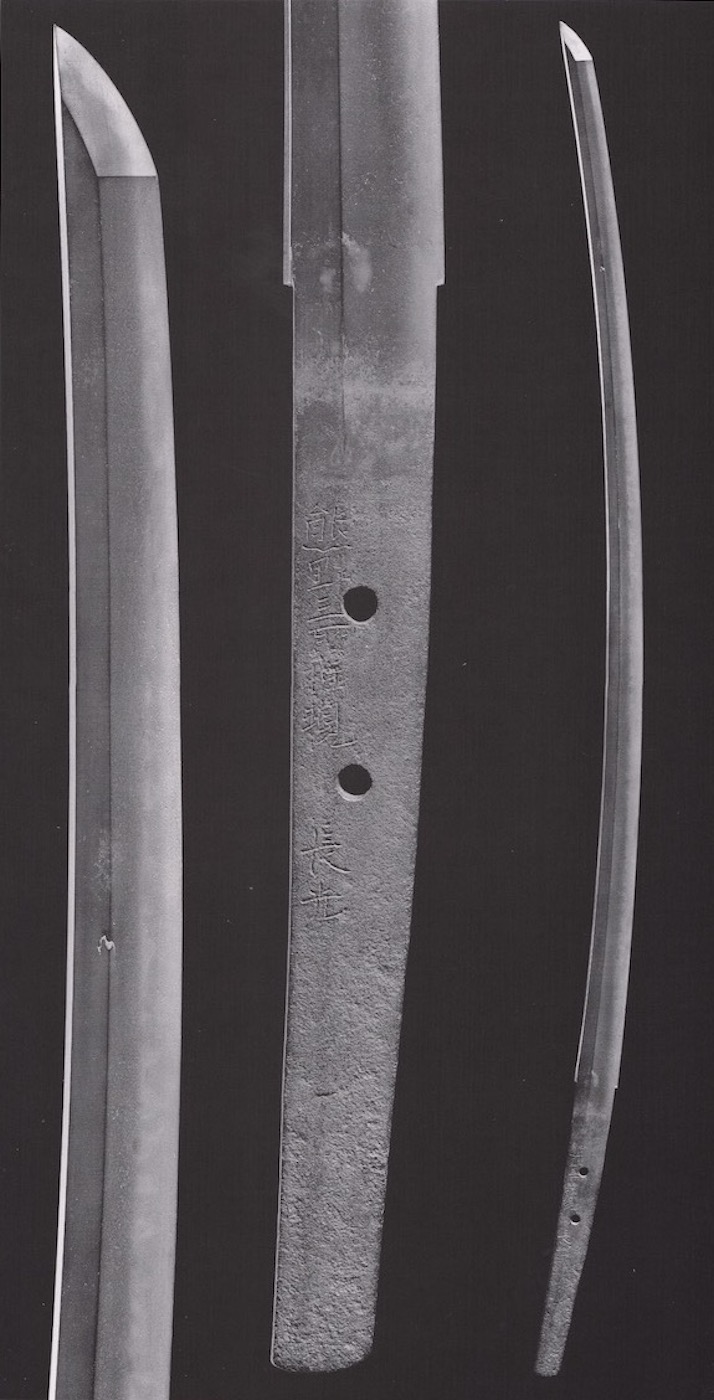

Measurements: nagasa - 75.2 cm; sori - 2.9 cm; motohaba - 3.0 cm; nakago nagasa - 22.7 cm.
Figure 19: Kokuhō Sansho Gongen Nagamitsu. Private Collection.
8.Suguha-chō mixed with ko-chōji. Swords with slender sugata, based on chū-suguhar mixed with ko-chōji or chōji-ashi; san-saku bōshi; very high level of kitae; fine chōji-utsuri; nioiguchi line is tight and elegant; the signature was located slightly at the top right of the nakago; a lot of swords forged in this style have survived. (around 15% of all extant Nagamitsu’s swords).




Measurements: nagasa - 75.14 cm; sori - 2.6 cm; motohaba - 3.1 cm; sakihaba - 1.9 cm; kissaki nagasa - 2.8 cm; nakago nagasa - 19.2 cm.
Figure 20: Tachi mei Nagamitsu, Jūyō Tōken #8.
9.Suguha. Suguha-ni-ashi tachi with hoso-mi (slender) sugata; san-saku bōshi; fine chōji-utsuri; nioiguchi line is tight and elegant; suguha hamon combined with chōji-utsuri became the characteristic feature of the Osafune School swords between the Einin (永仁, 1293-1299) and Kagen (嘉元, 1303-1306) eras. The second feature is that the lower right tilting “leg” (sixth stroke) of the “Mitsu” kanji not always ends after the parallel line with a «hook shape», in the classic manner; on the contrary, the parallel line ends in a rounding. (around 15% of all extant Nagamitsu’s swords)

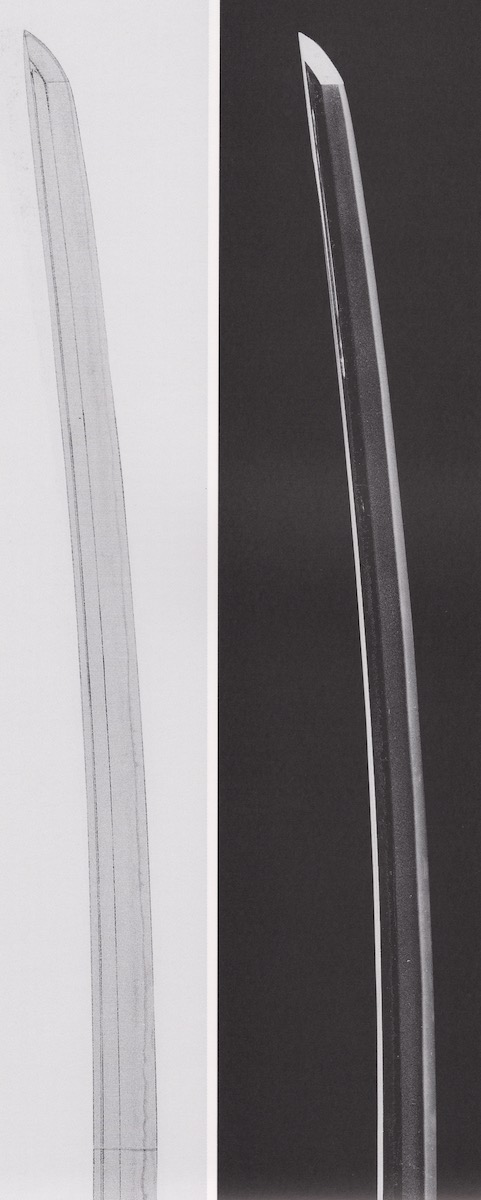

Measurements: nagasa - 80.2 cm; sori - 2.5 cm; motohaba - 2.95 cm; sakihaba - 1.6 cm; kissaki nagasa - 2.25 cm; nakago nagasa - 23.0 cm.
Figure 21: Tachi mei Nagamitsu, Jūyō Tōken #28.
The creative activity of Nagamitsu can be viewed both from the point of view of the analysis of the extant works, and from the point of view of information about the master and his works, which has come down to us in the records in old manuscripts. Both of these approaches have significant drawbacks. Analyzing the surviving works, we cannot be completely sure that all of them, even the signed works, were forged by Nagamitsu himself, and not by his successors and disciples, not to mention unsigned works. Nagamitsu’s creativity is extremely diverse and varied.
As for the second approach, analyzing the records preserved in the old manuscripts, one can clearly see the border located somewhere in the Muromachi period and clearly separating two theories: one generation of the master and two generations. The reasons for the emergence of the theory of two generations cannot be fully understood, but at the same time it is also impossible to agree with the generally accepted point of view that it arose due to a lack of information and a lost connection between experts from the Muromachi period and earlier periods. It should be clearly understood that the old manuscripts of the Kamakura and Nanbokuchō periods were very short and did not contain detailed information compared to later sources. Therefore, one cannot speak of a lack of information; on the contrary, one can speak of an explosive increase in the volume of information. One can argue about the sources of such an increase in the amount of information and analyze the reasons why the expert of the Muromachi period knew much more than the expert of the Nanbokuchō period, but at the present time it is impossible to put an end to this issue.
Sakon Shōgen title
There has been uncertainty and oddity regarding the official title of Nagamitsu since ancient times. For example, in the Kanchi-in Bon Mei Zukushi, Nagamitsu is described without any title, while his younger brother Sanenaga is described with the official title Sakon Shōgen (左近将監), and his son Kagemitsu with the title Saemon no Jō (左衛門尉). The title of Sakon Shōgen or Sakon no Shōgen can be conventionally interpreted as "the commander of the left flank of the army» and has the highest 6th rank in the classification of the titles of swordsmiths in Japan. The title Saemon no Jō can be conventionally interpreted as «the guard of the left-side gates of a castle». If we draw an analogy with military ranks, then Saemon no Jō corresponds to the rank of lieutenant, and Sakon Shōgen corresponds to the rank of colonel.
Regardless of whether the ancient manuscripts explicitly mention that Nagamitsu has an official title, the very principle of presenting information in these books implies that Nagamitsu has an official title. This title could change depending on a change in the position of the blacksmith himself in the hierarchy of the school, and old books consider this a well-known fact that does not require special mentioning and additional detailing. That is, the authors of the old manuscripts at the time of their writing were completely sure that a qualified reader himself is able to understand what kind of title Nagamitsu had in accordance with the hierarchy adopted at that time in the Osafune School.
In this regard, the meaning of the title Sakon Shōgen in the line of swordsmiths of the Osafune school needs to be more clearly defined. This is precisely the official title of Nagamitsu, and not the first name, the first mention of which can be found back in the Kaji-meiji-kō (鍛冶銘字考). Therefore, in old manuscripts it is often found the followed inscription: "Nagamitsu Sakon Shōgen, son of Mitsutada", although it is generally accepted among the followers of the theory of two generations that Sakon Shōgen is the second generation and, therefore, the son of nidaico Nagamitsu. Probably shodai Nagamitsu also could bear this title when he inherited the forge from Mitsutada in his twilight years. Indirect confirmation of this theory can be the differences in the chiselling of the name Sakon Shōgen on the surviving signed Nagamitsu swords, as well as the fact that only in the manuscripts of the Edo period appeared a clear difference for names which was not been found earlier: 1st generation - Saemon no Jō; 2nd generation - Sakon Shōgen.
Nagamitsu dated works
For signed Kotō period masterpieces that extant, Nagamitsu ranks in first place of all swordsmiths. This is in part due to the large workshop that he built and that his many disciples were so highly talented and able to increase the swords production that the group was responsible for. And the other part of it is simply that his work has been held in the highest regard since the time of its manufacture, and because of this, a great number of masterpiece blades were preserved over the centuries. Nagamitsu was one of the few craftsmen who achieved a unique combination in his work: functionality, beauty, quality and the ability to successfully withstand high shock loads.
A list of dated works by Nagamitsu can be represented in the following table:
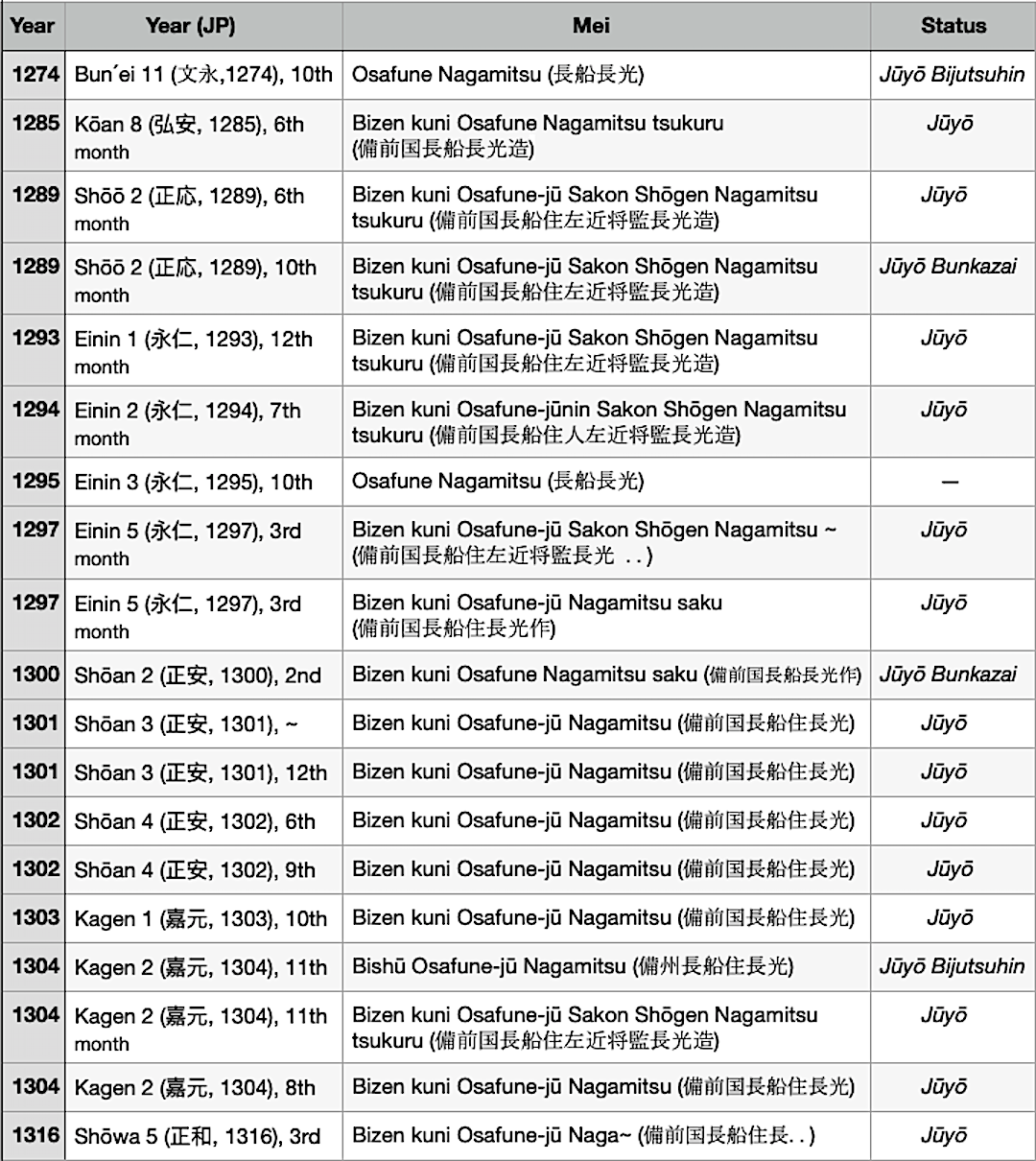
Analyzing this table, it can be noted that the earliest date is 1274. Based on this, in many Meikan books, adhering to the theory of one generation, the peak of Nagamitsu's creative activity is called Shōō era (正応, 1288-1293). However, in this case, there is an incredibly large gap with the period of creative activity of his father Mitsutada, which is defined as Ryakunin era (暦仁, 1238-1239). In this regard, the most preferable version seems to be that shodai Nagamitsu very rarely dated his works and signed them in the niji-mei style. Unfortunately, these rare examples have not survived until our time.
It is known that Nagamitsu's father, Mitsutada, did not date his works, most of which are signed in the niji-mei style. Also no dating was found on swords inscribed in the naga-mei style. Although it is impossible to say exactly when Mitsutada ended his swordsmithing career, all indirect indications show that he finished it before the Bun ́ei era (文永, 1264-1275). Therefore, the succession of Nagamitsu looks obvious, at an early stage in his smith's career, he signed with niji-mei and did not indicate the date of manufacture. Most of the dated works are signed using the official title Sakon Shōgen, which corresponds to the period of activity of nidai Nagamitsu.
Junkei (順慶)
Old manuscripts say that when Nagamitsu retired and abdicated the forge to the second generation, he took on the monastic name (hōmyō, 法名) Junkei and continued producing swords. Today this theory is dismissed and Junkei is understood to be a different smith. So this is something again to take note when studying the smith and considering swords. Since the early Muromachi period, there has been a theory that Junkei was Osafune Nagamitsu’s priest name after he became a priest or monk. After examining Junkei’s work, the opinions were that that he was a different person from Nagamitsu.
The first mention of the monastic name Nagamitsu can be seen in the Ōseki Shō (往昔抄, 1519, based on drawings of sword tangs done by Saitō Toshiyasu [斎藤利安, ?–1530]), where the following is literally said on the nakago: 順慶 備前初長光入道シテノ銘也 i.e Junkei is Bizen shodai Nagamitsu monastic name. Further, the same information is duplicated in the Kokon Meizukushi Taizen, which was written more than 100 years later and is based on information from the Ōseki Shō.
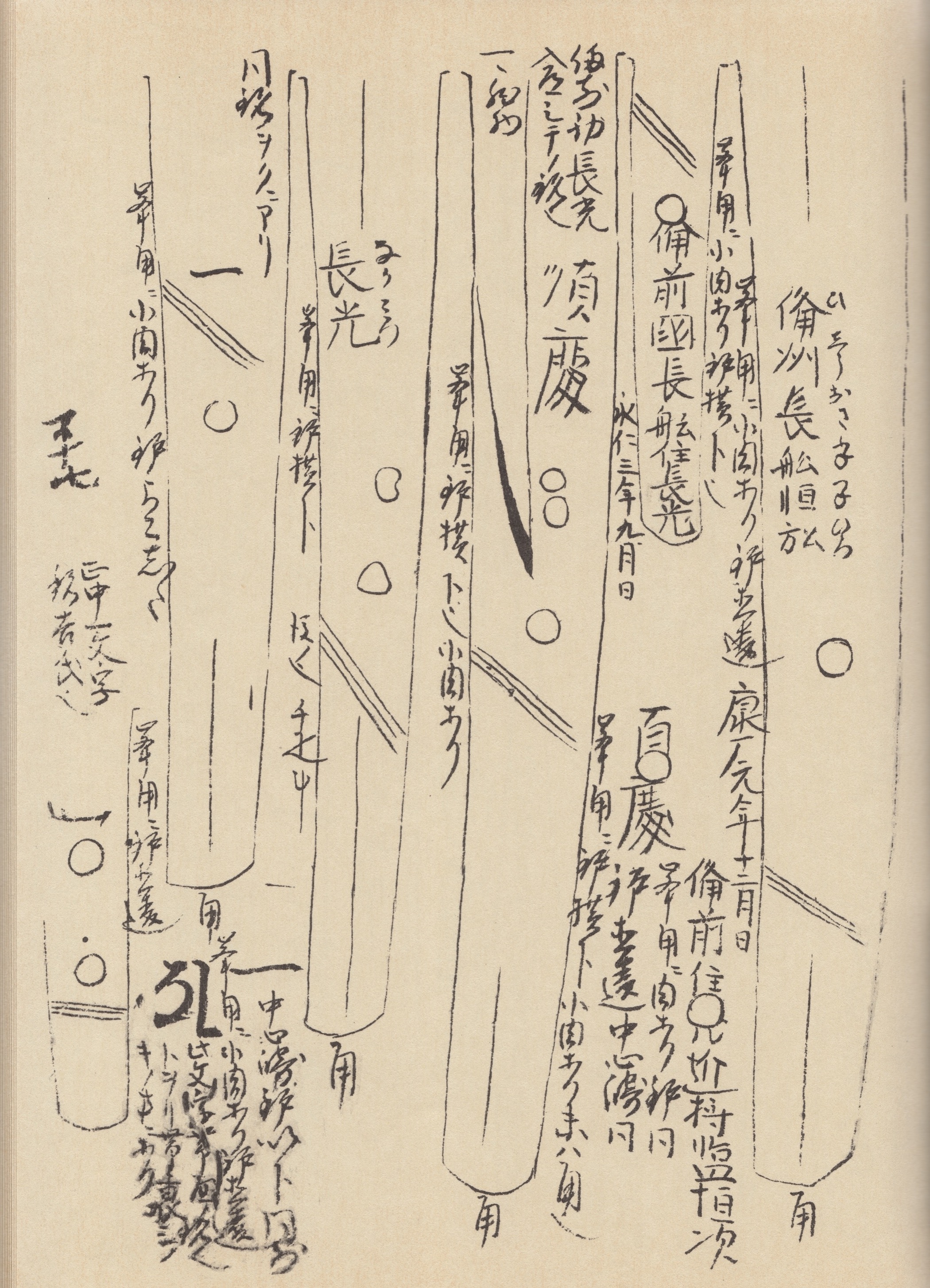
Figure 22: Ōseki Shō, new edition by Honma Kunzan (本間薫山) 1978, p. 117.
The Genki-gannen Tōken Mekiki Sho contains information about a sword made by Junkei, written in a different kanji (淮慶), but which is most likely monastic name Junkei. The modern analysis of the works signed by Junkei is based solely on the five surviving swords: two signed Jūyō, two signed Jūyō Bijutsuhin and two signed Jūyō Bunkazai. They all exhibit similarities such as: the hamon is a ko-gunome in ko-nie-deki with some pointed yaki-gashira, ashi and yō, without utsuri, the bōshi is a chū-maru with hakikake or appears almost as yakitsume with only a very small kaeri. Sugata of the Junkei’s swords is also differ: tachi are less elegant with shallow sori and elongated kissaki.
However, it is not entirely correct to make a definitive conclusion about the difference between the styles of Nagamitsu and Junkei on the basis of several surviving works. Moreover, it does not logically follow from the difference in the styles that these swords were forged by different persons. After the shodai Nagamitsu retired and became a monk, he could occasionally continue to forge swords, but do so based on his current capabilities, and therefore the style of these works could be different. In other words, Nagamitsu-Junkei no longer had access to the production capabilities of the Osafune factory, both in terms of quality raw materials and highly skilled assistants, which simply did not allow him to maintain the quality of forging at the same level, forcing simpler solutions.
It is possible that the swords bearing the Junkei’s signature or attributed as Junkei were actually forged by Nagamitsu himself. These swords were a compromise between Nagamitsu's genius and his current technical and manufacturing capabilities as a monk in his twilight years. This makes us think once again how important a good technical base, a large, strong school and the patronage of an influential clan were at that time. The same patterns can be traced in the work of Sōshū Sadamune. After he moved to Takagi, his works lost some of their beauty and quality due to the fact that Sadamune no longer had a connection with the powerful production base of Kamakura and the Sagami School.
Roughly the same can be said for the differences in the signatures style of Nagamitsu and Junkei. The main difference is the another sizes of the kanji used for signatures, but this is also not entirely true, since it is necessary to take into account the surviving osigata in the analysis. For example, on the osigata in the Ōseki Shō it is clear that the sizes of the kanji for Nagamitsu and Junkei are the same.
Examining old manuscripts, one can find a lot of information that the work of Junkei was valued above Nagamitsu, which casts doubt on the generally accepted point of view in our time that the quality of Junkei swords is inferior to Nagamitsu. The secret list of the most valuable swordsmiths presented in the Genki-gannen Tōken Mekiki Sho, looked like this:
- Junkei (順慶), monastic name of Nagamitsu, Bizen;
- Hisakuni (久国), Tōjirō (藤次郎), Awataguchi;
- Kunitoshi (国俊), Minamoto Raitarō (源来太郎), Yamashiro;
- Tomonari (友成), Bizen;
- Morishige (守重), monastic name Unshō (雲生), Bizen.
This shows that Junkei's name as a swordsmith was well known at that time and his work enjoyed the highest reputation.
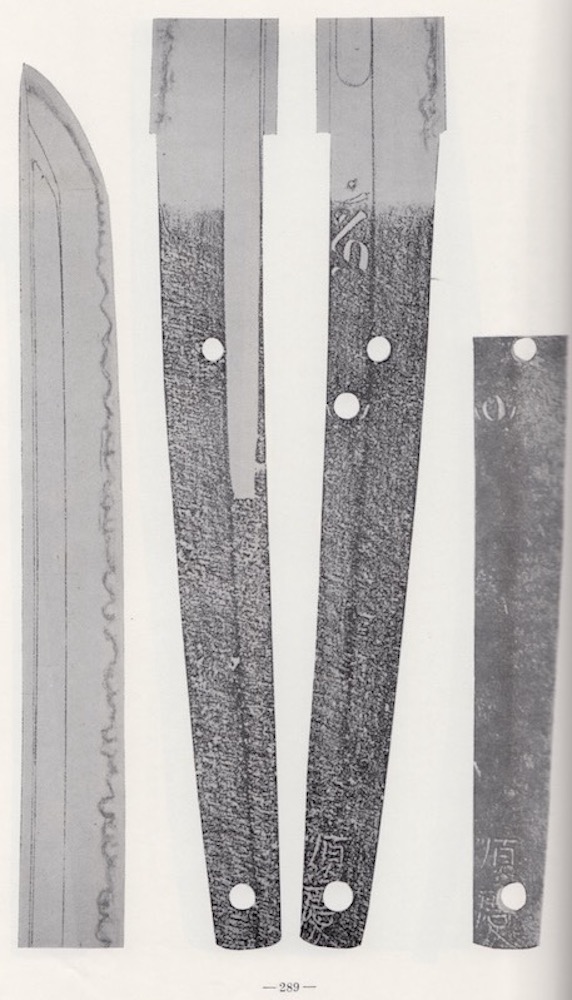
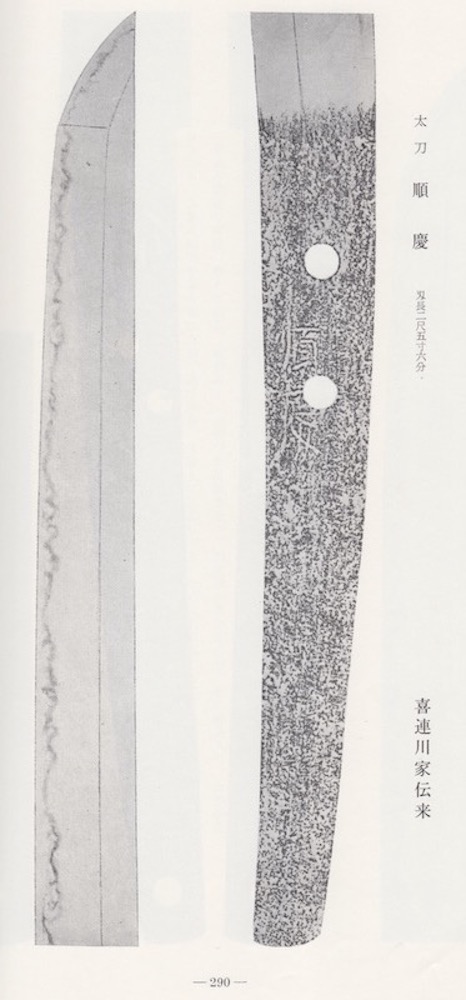
Figure 23: Swords signed Junkei; the Nihonto Bizen Den Taikan by Okazaki. 1975, pp. 298, 290.
Sansaku Bōshi
The sansaku-bōshi (三作帽子) is a term that appeared at the end of the Edo period and can be literary translated as “bōshi of the Three Great Masters”. This refers to the three great masters of the Bizen Osafune school: Nagamitsu, Kagemitsu, and Sanenaga who tempered the kissaki in a very similar manner. It is formed by a suguha that runs shortly straight and unchangeably over the yokote and follows then in a slightly undulating manner the fukura to turn back in a compact ko-maru-kaeri. This is the most key kantei point when assessing Nagamitsu work. Not all Nagamitsu works have this, earlier works will not show it.
A striking example of sansaku-bōshi can be seen on the examples of the Jūyō Tōken #8 and #28 swords shown in the Figures 20 and 21. Especially, take a look at Figure 8, made during the late Muromachi period years and showing the difference between bōshi in the works of Mitsutada, Nagamitsu and Kagemitsu.
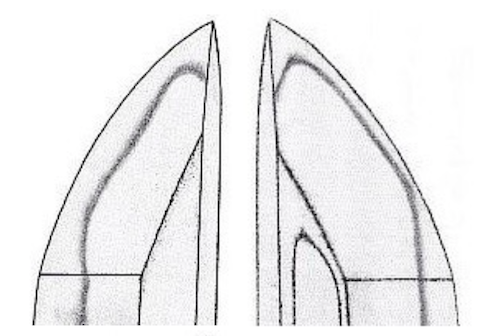
Figure 24: Construction of the sansaku-bōshi.
Masterpieces by Nagamitsu
To date, we know of the existence of 75 works by Nagamitsu of the highest rank categories. There are 40 Jūyō Bijutsuhin, 29 Jūyō Bunkazai, and 6 Kokuhō swords attributed to Nagamitsu. I addition, currently, we know of 136 works by Nagamitsu of the Jūyō category and 25 works having the status of Tokubetsu Jūyō.
In relation to Nagamitsu, another very interesting occurrence can be mentioned: there are an unusually large number of extant swords, both signed and unsigned (simply attributed to Osafune Nagamitsu). To be exact, 236 of Nagamitsu’s swords (Jūyō and above) are extant, and this is the first-highest number of registered surviving swords, more than extant works of Kanemitsu, ranked second in the list (227 swords, Jūyō and above, are attributed to Kanemitsu). The large number of higher ranking Nagamitsu swords with papers issued by the Ministry of Education, Culture, Sport, Science, and Technology folded in with the Tokubetsu Jūyō works easily ranks him first overall.
It is a well-known fact that a large number of Nagamitsu swords have preserved accompanying documents of their origin from the collections of the Imperial House, the Tokugawa Shōgunate, the Matsudaira family and daimyō clans such as Date, Ikeda, Honda, Nabeshima, Shimazu, Tachibana, Uesugi, Many works are kept in the most famous museums in Japan: Tōkyō National Museum, Kurokawa Museum of Ancient Cultures, Sano Museum of Fine Arts. Some Nagamitsu swords were personally shrined by various generations of the Tokugawa shoguns, in particular Tokugawa Ieyasu, as well, Toyotomi Hideyoshi and Oda Nobunaga treasured Nagamitsu blades.
Nagamitsu’s most famous meitō, meibutsu and gyobutsu
Sansho Gongen Nagamitsu (三所権現長光)
Nagasa - 75.2 cm; sori - 2,9 cm; motohaba - 3.0 cm.
Nagamitsu chiselled Kumano Sansho Gongen (熊野三所権現) on the sword’s nakago. This inscription can literary be translated as «three avatars of Kumano». The Kumano triad is composed of three Shintō deities and their Buddhist counterparts:
Hongū, Ketsumiko-gami (家都御子神) - Amida Buddha;
Shingū, Hayatamamiya (速玉神) - Yakushi Buddha;
Nachi, Fusumi (夫須美) or Musubi no Kami (結びの神) - 1000-armed Kannon Bodhisattva.
It seems to have been a special dedication piece for the Kumano shrine (熊野神社), which was administered by the Kuki (九鬼) clan. The Kuki clan likely had control of it since the sword manufacture by Nagamitsu. This blade was given to Oda Nobunaga by the Kuki clan, and then presented to Toyotomi Hideyoshi, then Uesugi Kenshin and then to Tokugawa Ieyasu. This blade was returned back to Kuki Mimbu Shoyu Uemoto by Tokugawa Yoshimune (8th shōgun) and it has been treasured in the Kuni family for many generations until the present, when it was sold to Hosokawa of Higo and then to a private collector.
Tsuda-Totomi Nagamitsu (津田遠江長光)
This sword with nagasa 71.96 cm was valued at 200 mai and was the gyobutsu of Oda Nobunaga (presumably sword was known as Ebi no se when Nobunaga owned it). It was one of the favourite sword of Nobunaga and after his death on the 2nd of June 1582, Akechi Hyuga no Kami picked up this sword from Azuchi castle and gave it to Uto Tsuda Totomi. He became a ronin and then a retainer of Maeda Toshinaga. After Totomi’s death, his 2nd son Genemon gave it to Maeda Toshinaga. At the Princess Matsu wedding ceremony this sword was presented to Tokugawa Tsunayoshi. Probably, it is the best of all swords by Nagamitsu and currently is in the Owari Tokugawa Reimeikai Foundation Collection.
Kanna-giri Nagamitsu (鉋切長光)
This sword with nagasa 59.09 cm was valued at 25 mai and was the gyobutsu of Toyotomi Hideyoshi. Initially, the sword belonged to Gamō Ujisato (蒲生氏郷, 1556 - 1595). Blade was given to Sasaki clan (佐々木氏), then was presented to Toyotomi Hideyoshi who passed it on to Tokugawa Ieyasu around Tenshō era (天正, 1573-1592). At the Tokugawa Hidetada’s daughter wedding ceremony he gave this sword to Mori Tadahiro. Tadahiro’s son Naiki Nagatsugu presented this sword to Tokugawa Ietsuna in 1674 and since that times it was treasured in the shōgunate. In December 1923, Tokugawa Ietatsu presented Kanna-giri Nagamitsu to Tokugawa Kuninari (head of Mito Tokugawa clan) and this sword is still treasured by Mito Tokugawa.
The Kanna-giri nickname goes back to legend about a samurai who owned this sword in ancient times. Ones upon a time, Katata Matagoro who was samurai from the Omi Province, was traveling along the road near Ibukiyama accompanied by a carpenter. During a conversation with the carpenter, a phrase fell out of his tongue, which infuriated the samurai. Matagoro sensed some change in the carpenter and realized that he was possessed by a demon. Matagoro drew his sword and hacked the carpenter, who was trying to defend himself with his plane. The sword with which the samurai struck was forged by Nagamitsu and it cut through the plane and the carpenter. Thus, the sword got its name: Kanna (plane) giri (cutter).
Kosai Nagamitsu (香西長光)
This sword with nagasa 57.27 cm belonged to Kosai Motonaga (香西元長) also known as Kosai Mataroku (香西又六). Kosai was a retainer and one of the ministers of Hosokawa Masamoto (細川政元). He gained fame as the murderer of his master by plotting betrayal. Masamoto who was childless adopted Sumiyuki and Sumimoto as his sons.The retainers of Hosokawa disputed for very long to who the successor of the Hosokawa would be. In 1504, Masamoto eliminated Yakushiji Motoichi who was a follower of Sumimoto (whom he did not want as successor). In 1506, Masamoto was threatened by an army led by Miyoshi Yukinaga, another supporter of Sumimoto. Due to Masamoto then choosing someone else as the successor, Kosai Motonaga, along with Sumiyuki, broke into the house of Hosokawa Masamoto located near Atagoyama on the 23rd of June 1507 and killed him while he was taking a bath.
After Kosai's death, Nagamitsu's sword went to Matsunaga Danjo Hisahide (松永弾正久秀), who gave it to Oda Nobunaga, who in turn presented it to Toyotomi Hideyoshi. This sword was donated to Hokoku shrine in Kyōto by Toyotomi Hideyori and and Tokugawa Ieyasu took it from here. Kosai Nagamitsu was lost in fire that followed the Tōkyō earthquake in 1923 where the Mito mansion was completely destroyed.
Hachiya Nagamitsu (蜂谷長光)
This sword with nagasa 56.06 cm was valued at 30 mai. Little is known about this sword, except that during Hideyoshi's time it was belonged by a man named Hachiya. The sword was in the Okudaira collection and then was acquired by the Okano Museum. The sword has Jūyō Bunkazai status.
Dai Hannya Nagamitsu (大般若長光)
This sword with nagasa 73.6 cm and sori 2.9 cm was valued at 600 kan. This sword looks a lot like Mitsutada, but it is still one of the best swords forged by Nagamitsu. Hannya kyo is one of the Buddhist scripture."Hannya" means wisdom and spiritual awaking. There are 600 volumes of the Hannya kyo and in process of sword’s evaluation this scripture was attached to the blade instead of use kan measurement. Thus, this name came to accompany the sword. This sword belonged to Ashikaga Yoshiteru, then went to Miyoshi Chokei and finally came to Tokugawa Ieyasu, who in turn gave it to Okudaira Nobumasa. The sword became Okudaira clan heirloom for many generations. The Dai Hannya Nagamitsu is currently kept in the Tōkyō National Museum.
Original content Copyright © 2020 Dmitry Pechalov